

Shackleton’s Journey – Planning Overview
Written by Dan
Last updated March 8, 2024
The story of Ernest Shackleton’s incredible journey has captivated audiences for over a century. An endurance feat like no other, the famous Antarctic explorer faced impossible odds and unfathomable perils to survive his remarkable voyage – but with strong leadership, carefully crafted plans, and an unwavering determination, he ultimately gave future generations a heroic tale of resilience that still resonates today.
For teachers looking to introduce this extraordinary story in their classrooms, it can seem overwhelming to cover such an expansive topic effectively.
However, by breaking down the essential elements of Shackleton’s journey into manageable planning points, you, too, can traverse the icy terrain and deliver an inspiring lesson your students will never forget!
Related : For more, check out our article on Harry The Poisonous Centipede here.
Table of Contents
Shackleton’s Journey by William Grill
Shackleton’s journey is a beautiful and inspiring children’s book written and illustrated by William Grill. The book tells the story of Sir Ernest Shackleton and his crew as they set out on a dangerous expedition to cross Antarctica in 1914.
The journey began when Shackleton and his men sailed from England on the ship Endurance. They encountered many challenges, including treacherous weather conditions, thick ice, and hungry polar bears. Despite these obstacles, they persevered and continued on their journey.
However, disaster struck when the Endurance became trapped in ice for months. The crew was forced to abandon the ship and camp on an ice floe. They had limited supplies and were far from any civilization.
Despite these dire circumstances, Shackleton remained optimistic and determined to save his men. He led rescue missions over several months, braving freezing temperatures and dangerous terrain to reach safety.
All of Shackleton’s men survived thanks to his leadership and determination. The story of Shackleton’s Journey is a testament to the human spirit, showing that even in the face of extreme adversity, we can find hope and strength within ourselves.
Critical Themes In Shackleton’s Journey
Perseverance:.
This theme is evident throughout the story as Shackleton, and his crew face numerous challenges on their journey, including treacherous weather conditions, thick ice, and hunger. Despite these obstacles, they continue their mission, showing remarkable perseverance and determination.
Leadership:
Shackleton’s leadership skills are on full display in this story. He remains calm and focused even in the most challenging situations, inspiring his men to follow him and trust his decision-making abilities. His leadership ultimately leads to the successful rescue of his crew members.
The Endurance crew must work together to survive in harsh conditions with limited resources. They rely on each other for support and encouragement, demonstrating the importance of teamwork in achieving a common goal.
Even when faced with seemingly insurmountable challenges, Shackleton never loses hope that he will be able to save his men. His unwavering optimism inspires those around him to keep going despite the odds.
Resilience:
The crew demonstrates incredible resilience as they endure months of living on an ice floe with limited supplies and uncertain prospects for rescue. They find ways to adapt to their circumstances and persevere through difficult times.
Main Characters in Shackleton’s Journey
Here are the main characters in Shackleton’s Journey:
- Sir Ernest Shackleton – The expedition’s leader and the story’s protagonist.
- Frank Hurley – The photographer who documents the journey through photographs.
- Tom Crean – A skilled seaman who becomes one of Shackleton’s most trusted men.
- Frank Worsley – The captain of the Endurance, responsible for navigating the ship through treacherous waters.
- The crew of the Endurance – A group of 27 men from various countries who join Shackleton on his journey to cross Antarctica.
Teaching Opportunities
The story of Shackleton’s Journey can be an excellent tool for improving children’s writing skills in several ways:
- Vocabulary: The story is rich with descriptive language and technical terms related to sailing and exploration, which can help expand children’s vocabulary. Please encourage students to identify unfamiliar words and look up their meanings.
- Character development: The characters in the story are well-developed and complex, allowing students to analyze their motivations, actions, and relationships. Students can practice describing character traits and using evidence from the text to support their claims.
- Narrative structure: The story follows a clear narrative arc with a beginning, middle, and end. Students can study how the author builds tension and suspense throughout the story, using foreshadowing, imagery, and pacing techniques.
- Persuasive writing: Shackleton was known for his ability to inspire his crew members even in the most challenging circumstances. Students can analyze his leadership style and practice writing persuasive essays or speeches to motivate others toward a common goal.
- Research skills: The story of Shackleton’s Journey is based on actual events, providing an opportunity for students to conduct research on topics such as Antarctic exploration, sailing technology, or the history of polar expeditions. They can use this research to enhance their understanding of the story and incorporate factual information into their writing.
Key Vocabulary
Here are some key vocabulary words that children may encounter when reading Shackleton’s Journey, along with their definitions:
- Expedition – A journey or voyage taken for a specific purpose, often involving exploration or research.
- Antarctica – The southernmost continent on Earth, known for its extreme cold and ice-covered landscapes.
- Endurance – The name of the ship that Shackleton and his crew sailed on their expedition to Antarctica.
- Iceberg – A large piece of ice floating in the ocean, often dangerous to ships because it can be challenging to see.
- Navigation – The process of planning and directing the course of a ship or other vehicle.
- Arctic – The region around the North Pole, characterized by extreme cold and frozen landscapes.
- Sledging – Traveling over snow and ice using a sled pulled by dogs or humans.
- Blubber – A layer of fat beneath the skin of marine mammals, such as whales, used as a fuel source by Arctic explorers.
- Aurora Australis – Also known as the Southern Lights, a natural phenomenon where colourful lights appear in the sky over Antarctica due to solar activity.
By becoming familiar with these key vocabulary words, children will be better equipped to understand and appreciate Shackleton’s Journey story while expanding their language skills.
Lesson Plans
Lesson plan 1:.
Vocabulary Development Objective: Students can identify and define key vocabulary words from Shackleton’s Journey.
Materials Needed:
- Copies of Shackleton’s Journey or access to the text online
- Whiteboard or chart paper
- Introduce students to the concept of key vocabulary words, explaining that these are important words that they may frequently encounter in a particular text.
- Provide students with a list of key vocabulary words from Shackleton’s Journey (or have them create their own list as they read).
- Have students work in pairs or small groups to research the definitions of each word using dictionaries or online resources.
- As a class, discuss each word and its purpose, recording them on the whiteboard or chart paper.
- Please encourage students to use these words in writing and discussing the text.
Assessment:
Have students write short paragraphs using several key vocabulary words from Shackleton’s Journey, demonstrating their understanding of their meanings.
Lesson Plan 2:
Character Analysis Objective: Students will be able to analyze and describe characters from Shackleton’s Journey.
- Graphic organizers for character analysis (such as a character web or Venn diagram)
- Introduce students to character analysis, explaining that this involves studying a character’s traits, motivations, and relationships with other characters in a story.
- Please choose one or more characters from Shackleton’s Journey for students to analyze (such as Shackleton himself, Frank Worsley, or Tom Crean).
- Provide students with graphic organizers for character analysis and have them fill in details about each character based on evidence from the text.
- As a class, discuss each character and compare/contrast their traits and actions with those of other characters.
- Please encourage students to use what they’ve learned about these characters when writing about leadership, teamwork, or perseverance themes.
Have students write short essays describing one character from Shackleton’s Journey and how he contributed to the expedition’s success (or failure).
Lesson Plan 3:
Research Skills Objective: Students can research topics related to Antarctica exploration and incorporate this information into their writing.
- Computers with internet access
- Research prompts/questions related to Antarctica exploration
- Introduce students to some basic facts about Antarctica (location, climate, wildlife) and explain why it is an important area for scientific research.
- Provide students with research prompts/questions related to Antarctic explorers (Shackleton, Amundsen), sailing technology used during polar expeditions, or modern-day scientific research conducted in Antarctica.
- Have students work independently or in pairs/small groups using computers and online resources (such as National Geographic Kids) to research their chosen topic(s).
- Please encourage students to take notes on essential facts/details they discover during their investigation.
- Have students incorporate this information into their writing about Shackleton’s Journey – for example, by including historical context/background information at the beginning of an essay or incorporating scientific findings into a persuasive speech advocating for further exploration of Antarctica.
Have students present summaries of their research findings along with examples of how they incorporated this information into their writing about Shackleton’s Journey
Website Resources
Literacy Shed Plus: “Shackleton’s Journey” by William Grill This website offers a comprehensive set of resources for teaching Shackleton’s Journey, including lesson plans, activities, and worksheets. The resources are organized by key themes such as exploration, survival, and leadership. There are also links to relevant videos and websites for further research.
Link: https://www.literacyshedplus.com/en-us/resource/shackleton-s-journey-by-william-grill-en-gb
TES: 22-Lesson English Unit – Shackleton’s Journey by William Grill (Year 4/5/6) This resource provides a detailed unit plan for teaching Shackleton’s Journey throughout 22 lessons. The lessons are designed to cover a range of skills, including reading comprehension, writing, and speaking/listening. Each class includes learning objectives, activities, and assessment opportunities.
Link: https://www.tes.com/teaching-resource/22-lesson-english-unit-shackleton-s-journey-by-william-grill-year-4-5-6-english-planning-12691208
Teachwire: KS2 Book Topic – Shackleton’s Journey This website offers a brief overview of Shackleton’s journey and some ideas for related activities and discussion topics. It includes suggestions for incorporating the book into cross-curricular studies such as history and geography.
Link: https://www.teachwire.net/news/ks2-book-topic-shackletons-journey/
Q: What age group is Shackleton’s Journey suitable for?
A: The book is generally recommended for children in grades 4-6 but can also be adapted for younger or older students.
Q: What critical themes in the book can be explored in the classroom?
A: Some key themes include exploration, leadership, perseverance, teamwork, and survival.
Q: Are there any films or videos that can supplement the book?
A: Yes! There are several documentaries about Shackleton’s expedition that can provide additional context and visuals. “Endurance” and “Shackleton” are two popular options.
Q: How can I incorporate writing into my lessons on Shackleton’s Journey?
A: There are many opportunities for writing throughout the book. For example, students could write journal entries from the perspective of one of the crew members, create persuasive speeches advocating for different courses of action during the journey, or write reflective essays on what they learned from reading about this historic expedition.
Q: Can Shackleton’s Journey be used to teach other subjects besides English/Language Arts?
A: Absolutely! The book relates to many other subjects, such as history (exploration and polar expeditions), geography (mapping and climate), science (biology and ecology), and even math (calculating distances and supplies needed).
Q: How long does teaching a unit on Shackleton’s Journey typically take?
A: This will depend on how much time you have available in your curriculum. Some teachers may focus only on certain aspects of the book over a few days or weeks, while others may plan a more extended unit lasting several months.
Q: Are any online resources available to help me plan my lessons on Shackleton’s Journey?
A: Yes! Several websites offer lesson plans, activities, videos, and other resources related to teaching this book. Examples include Literacy Shed Plus, TES, and Teachwire (links provided in this article).
Related Posts
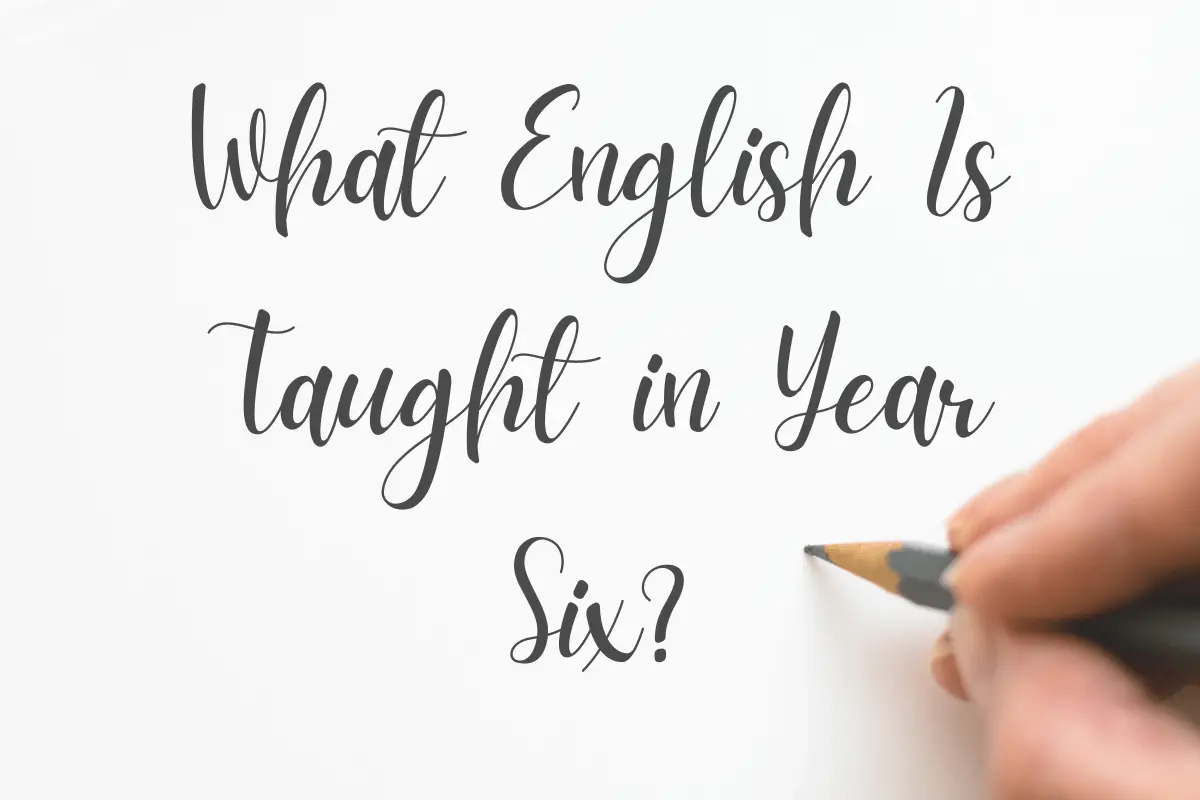
About The Author
I'm Dan Higgins, one of the faces behind The Teaching Couple. With 15 years in the education sector and a decade as a teacher, I've witnessed the highs and lows of school life. Over the years, my passion for supporting fellow teachers and making school more bearable has grown. The Teaching Couple is my platform to share strategies, tips, and insights from my journey. Together, we can shape a better school experience for all.

Join our email list to receive the latest updates.
Add your form here
Shackleton’s Journey: A Lovely Illustrated Chronicle of History’s Most Heroic Polar Expedition
By maria popova.

In August of 1914, legendary British explorer Ernest Shackleton led his brave crew of men and dogs on a journey to the end of the world — the enigmatic continent of Antarctica. That voyage — monumental both historically and scientifically — would become the last expedition of the Heroic Age of Antarctic Exploration, which stretched from 1888 to 1914. From Flying Eye Books — the children’s book imprint of British indie press Nobrow, which gave us Freud’s comic biography , Blexbolex’s brilliant No Man’s Land and some gorgeous illustrated histories of aviation and the Space Race — comes Shackleton’s Journey ( public library ), a magnificent chronicle by emerging illustrator William Grill , whose affectionate and enchanting colored-pencil drawings bring to life the legendary explorer and his historic expedition.

As Grill tells us in the introduction, Shackleton was a rather extraordinary character:
Shackleton was the second of ten children. From a young age, Shackleton complained about teachers, but he had a keen interest in books, especially poetry — years later, on expeditions, he would read to his crew to lift their spirits. Always restless, the young Ernest left school at 16 to go to sea. After working his way up the ranks, he told his friends, “I think I can do something better, I want to make a name for myself.”
And make it he did. Reflecting on the inescapable allure of exploration, which carried him through his life of adventurous purpose, Shackleton once remarked:
I felt strangely drawn to the mysterious south. I vowed to myself that some day I would go to the region of ice and snow, and go on and on ’til I came to one of the poles of the Earth, the end of the axis on which this great round ball turns.

From the funding and recruitment of the famed expedition, to the pioneering engineering of the Endurance ship, to the taxonomy of crew members, dogs, and supplies, Grill traces Shackleton’s tumultuous journey from the moment the crew set sail to their misfortune-induced change of plans and soul-wrenching isolation “500 miles away from the nearest civilization” to their eventual escape from their icy prison and salvation ashore Elephant Island.

As a lover of dogs and visual lists , especially illustrated lists and dog-themed illustrations , I was especially taken with Grill’s visual inventories of equipment and dogs:

Despite the gargantuan challenges and life-threatening curveballs, Shackleton’s expedition drew to a heroic close without the loss of a single life. It is a story of unrelenting ambition to change the course of history, unflinching courage in the face of formidable setbacks, and above all optimism against all odds — the same optimism that emanates with incredible warmth from Grill’s tender illustrations.

Years later, Shackleton himself captured the spirit that carried them:
I chose life over death for myself and my friends… I believe it is in our nature to explore, to reach out into the unknown. The only true failure would be not to explore at all.
Shackleton’s Journey is an absolute treasure. Complement it with Rachel Sussman’s journey in Shackleton’s footsteps .
Images courtesy of Nobrow
— Published February 26, 2014 — https://www.themarginalian.org/2014/02/26/shackletons-journey-william-grill-nobrow/ —

www.themarginalian.org

PRINT ARTICLE
Email article, filed under, books children's books ernest shackleton history illustration nobrow william grill, view full site.
The Marginalian participates in the Bookshop.org and Amazon.com affiliate programs, designed to provide a means for sites to earn commissions by linking to books. In more human terms, this means that whenever you buy a book from a link here, I receive a small percentage of its price, which goes straight back into my own colossal biblioexpenses. Privacy policy . (TLDR: You're safe — there are no nefarious "third parties" lurking on my watch or shedding crumbs of the "cookies" the rest of the internet uses.)
Writing Root Back to List

Resource written by
Alex chapman.
Associate Consultant
Resource Preview
A writing root for shackleton's journey.
£5.00 (inc. VAT)
KS: Lower KS2
Year Group: Year 4
Literary Theme: Unearthing Civilisations
Author(s): William Grill
- Description
- Spelling Seed
- Home Learning Branch
Packing lists (justifications), letters (formal and informal), setting descriptions, interviews, diaries, dialogue
Main Outcome:
Newspaper report
15 sessions, 3 weeks
Overview and Outcomes:
This is a three-week Writing Root for Shackleton’s Journey by William Grill in which children begin by discovering an advert asking for volunteers to join a ‘hazardous journey’. They then apply for one of the many roles on Shackleton’s expedition. Children then go on to use William Grill’s text to find out about the perilous adventure whilst creating interviews in role, writing both formal and informal letters and finally creating their own newspaper report about the events of Shackleton’s famous journey.
Synopsis of Text:
Shackleton's Journey is a unique visual re-telling Ernest Shackleton's landmark expedition crossing the Antarctic from one pole to the other. William Grill's impeccably researched and informative illustrations celebrate the 100th anniversary since the historic exploration by Shackleton and his crew on Endurance. Children will love exploring Grill's exploded diagrams and the fascinating details of this landmark voyage.
Text Rationale:
Shackleton’s Journey is a uniquely visual non-fiction re-telling of Ernest Shackleton’s epic expedition across the Antarctic. The text has a clear factual style as well as sparse but thought-provoking illustrations by William Grill which are highly engaging. This gives children an understanding of the period after the Victorians and the start of WW1 and about what life was like in Britain.
Links and themes:
Explorers, adventure, expeditions, famous people, friendship, resilience, determination and exploration
Date written: June 2017
A Spelling Seed is available for Shackleton's Journey.
Spelling Seed Overview:
This is a three-session spelling seed for the book Shackleton's Journey by William Grill. Below is the coverage from Appendix 1 of the National Curriculum 2014.
Spelling Seeds have been designed to complement Writing Roots by providing weekly, contextualised sequences of sessions for the teaching of spelling that include open-ended investigations and opportunities to practise and apply within meaningful and purposeful contexts, linked (where relevant) to other areas of the curriculum and a suggestion of how to extend the investigation into home learning.
There is a Spelling Seed session for every week of the associated Writing Root.
Word List Words
arrive, caught, imagine, island, medicine, accident(ally), calendar, earth, extreme, famous, sentence, mention
Spelling Rules and Patterns
More Prefixes: inter–, auto–, sub–
The suffix -ous
Home Learning Branch Overview:
This is a Home Learning Branch for Shackleton's Journey . These branches are designed to support home learners to access literature-based learning using a selection of books we love from Writing Roots. They include purposeful writing suggestions, links to the wider curriculum so that texts can be used across other subjects, key questions as well as spelling or phonics investigations.
Literary Leaves within the same Literary Theme
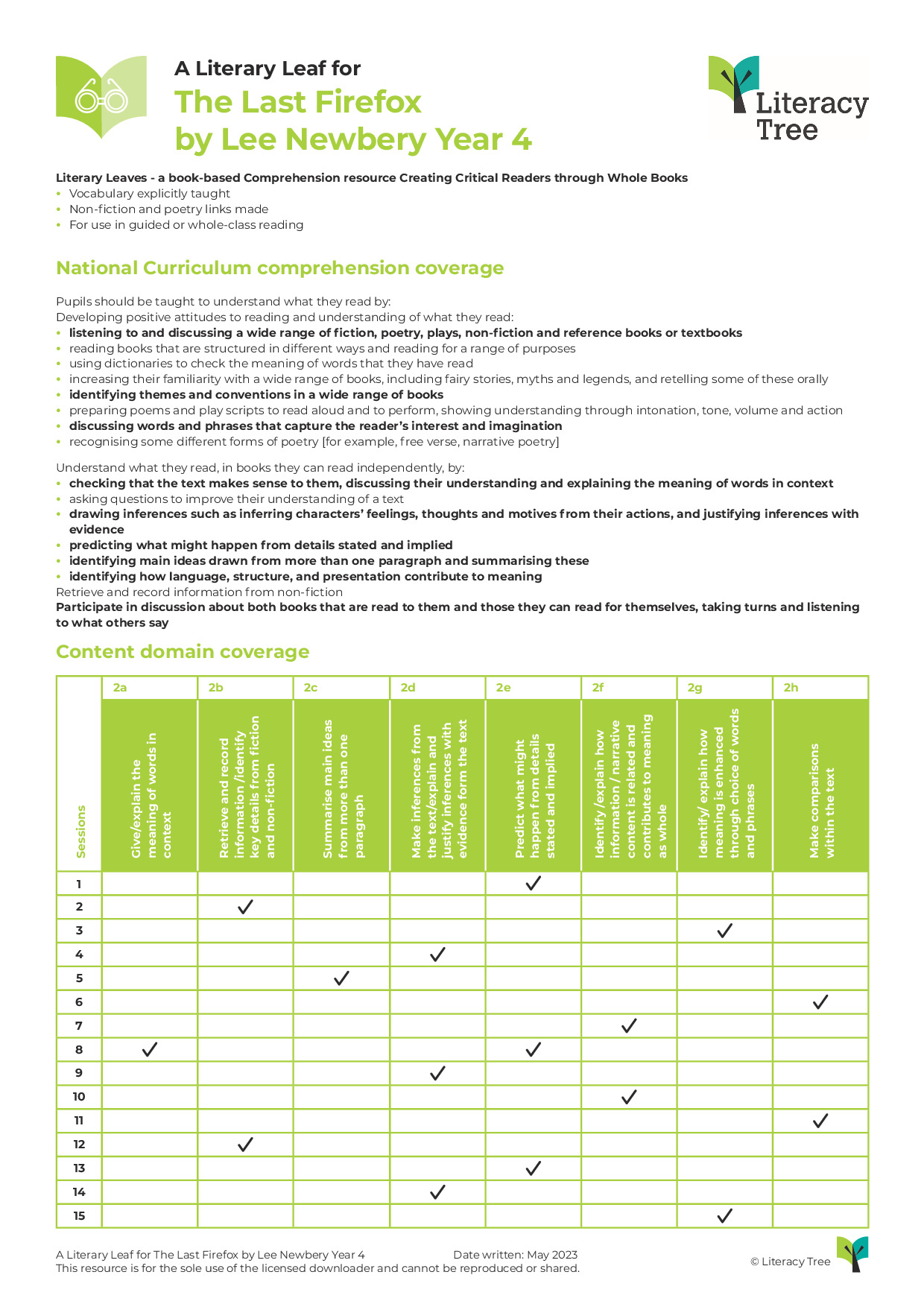
A Literary Leaf for The Last Firefox
Membership only.
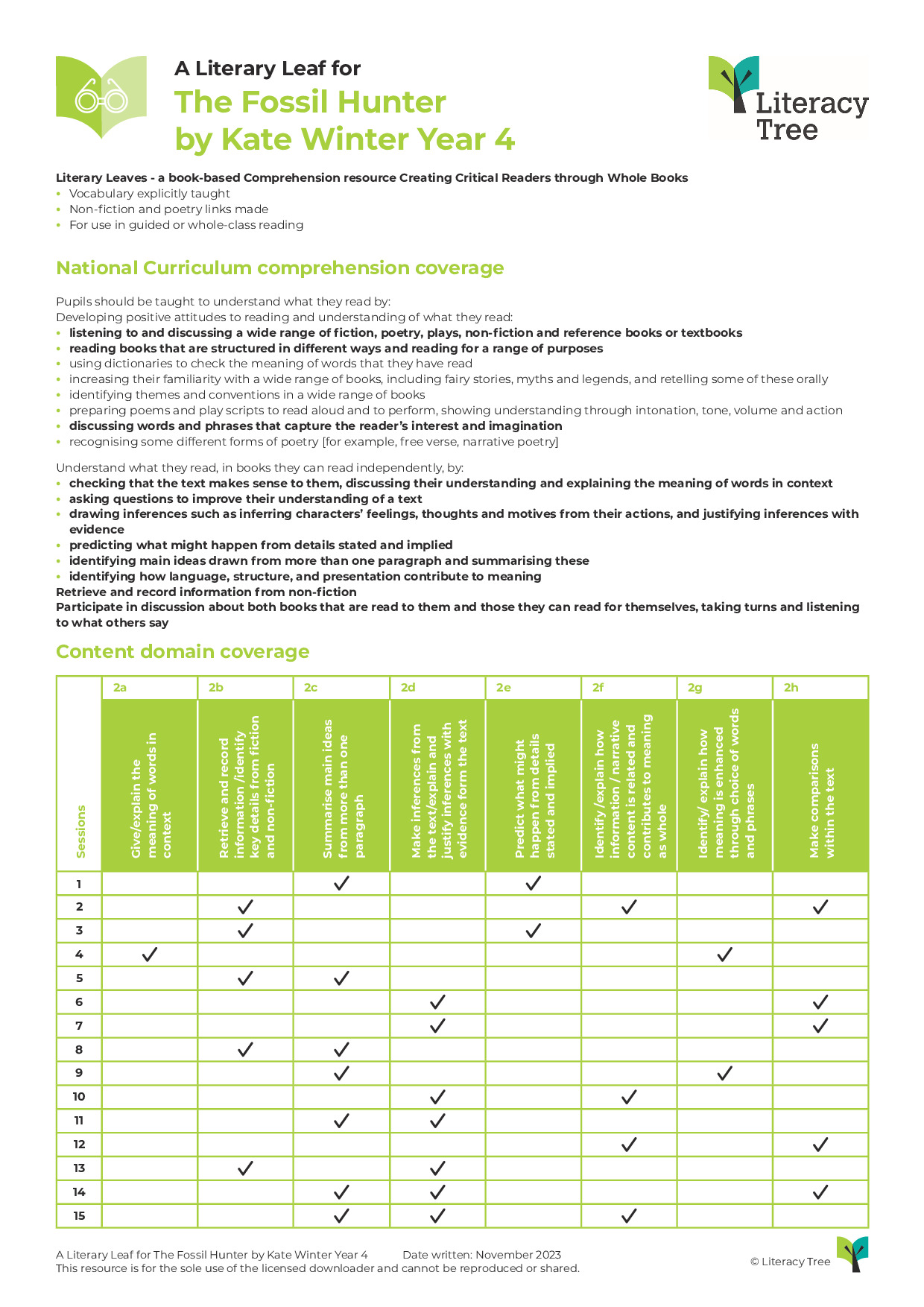
A Literary Leaf for The Fossil Hunter
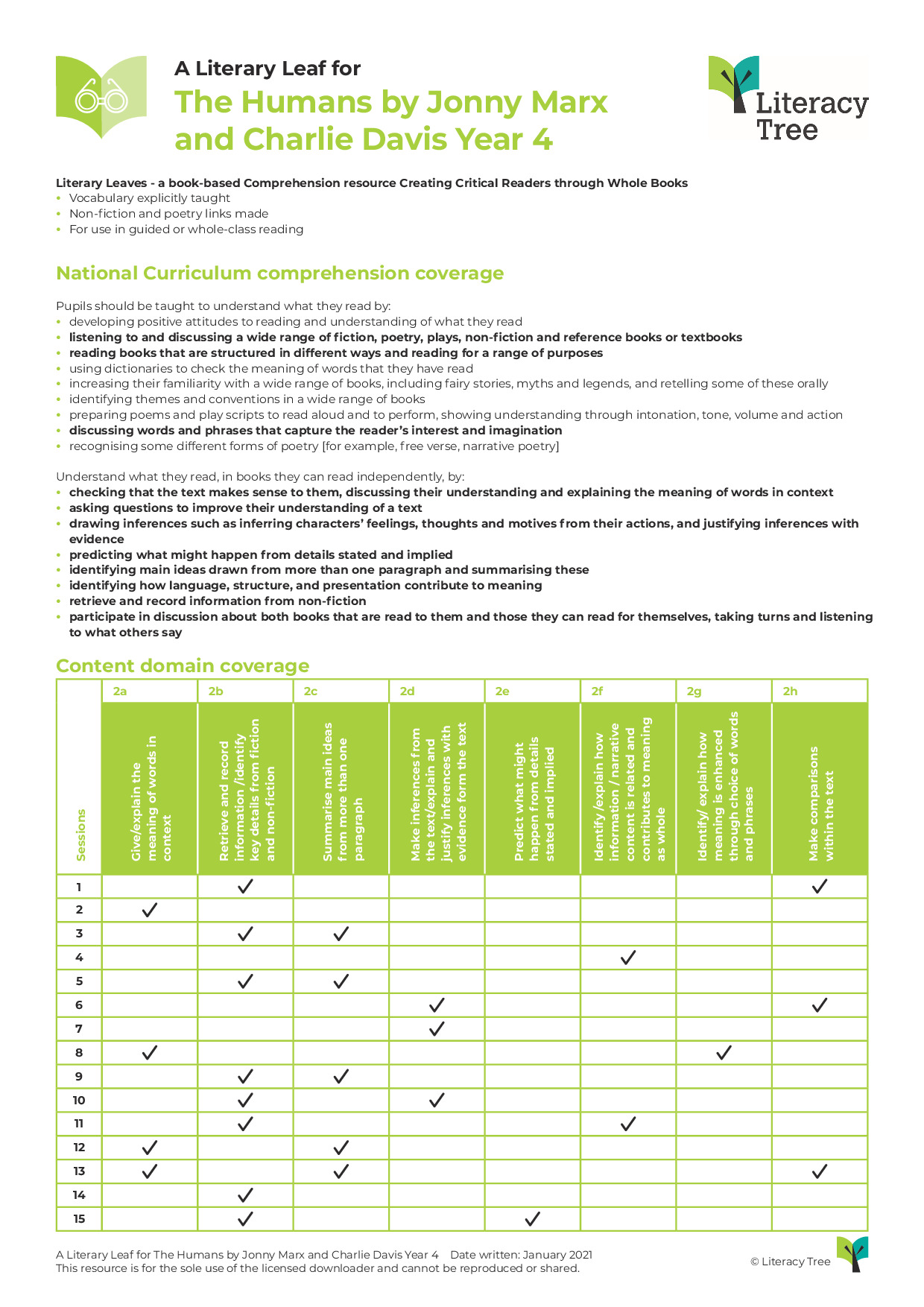
A Literary Leaf for The Humans
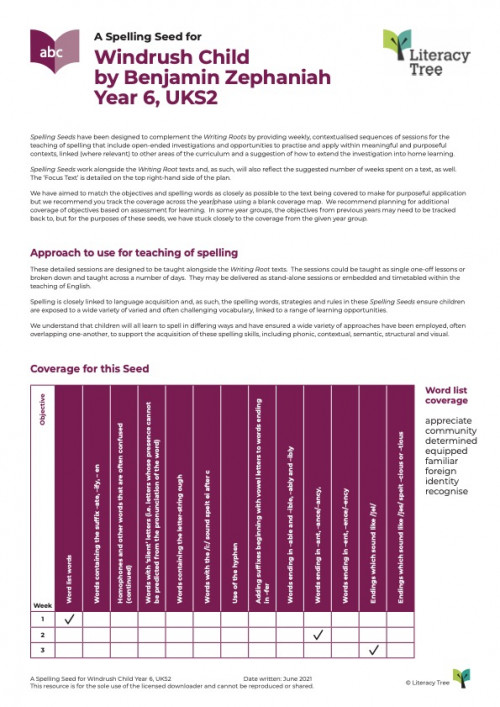
A Spelling Seed for Windrush Child
KS: Upper KS2
Year Group: Year 6

A Spelling Seed for The Unforgotten Coat
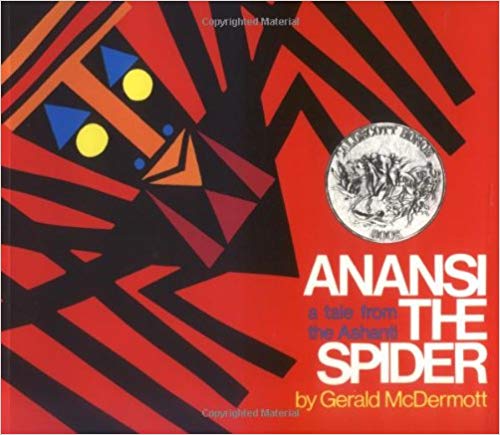
A Writing Root for Anansi the Spider
KS: R & KS1
Year Group: Reception

Username or E-mail
Remember Me
Shackleton’s Journey
Home » Book Resources » Lower Key Stage 2 » Shackleton’s Journey
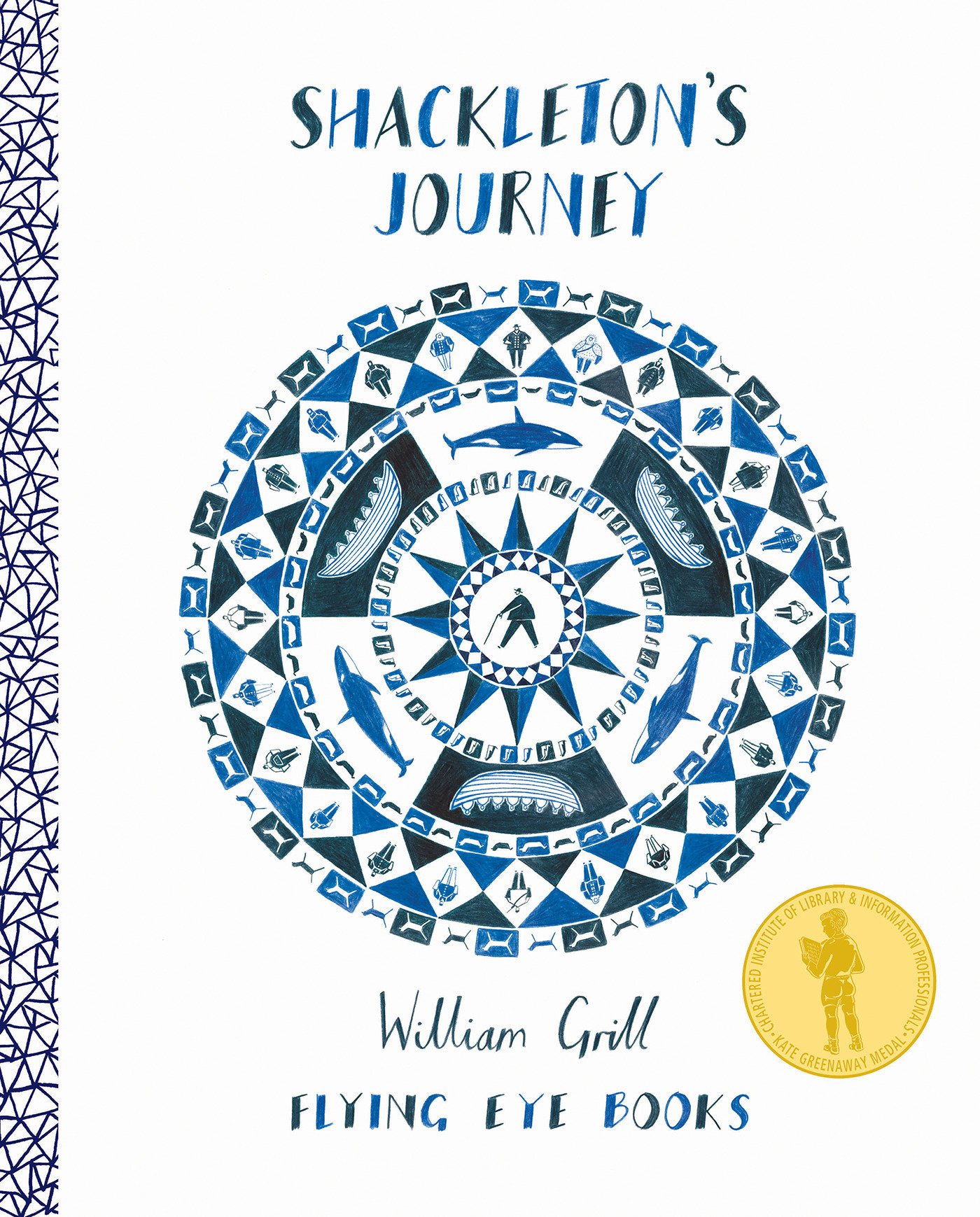
Shackleton's Journey by William Grill
In the last days of the Heroic Age of Exploration, Ernest Shackleton dreamed of crossing the frozen heart of Antarctica, a place of ferocious seas, uncharted mountains and bone-chilling cold. But when his ship, the Endurance became trapped in the deadly grip of the ice, Shackleton’s dreams were shattered. Stranded in a cold, white world, and thousands of miles from home, the men of the expedition set out on a desperate trek across the ice in search of rescue.
Shackleton’s Journey is the true story of how Shackleton and his crew managed to survive this epic adventure, and a testament to their great courage and endurance.
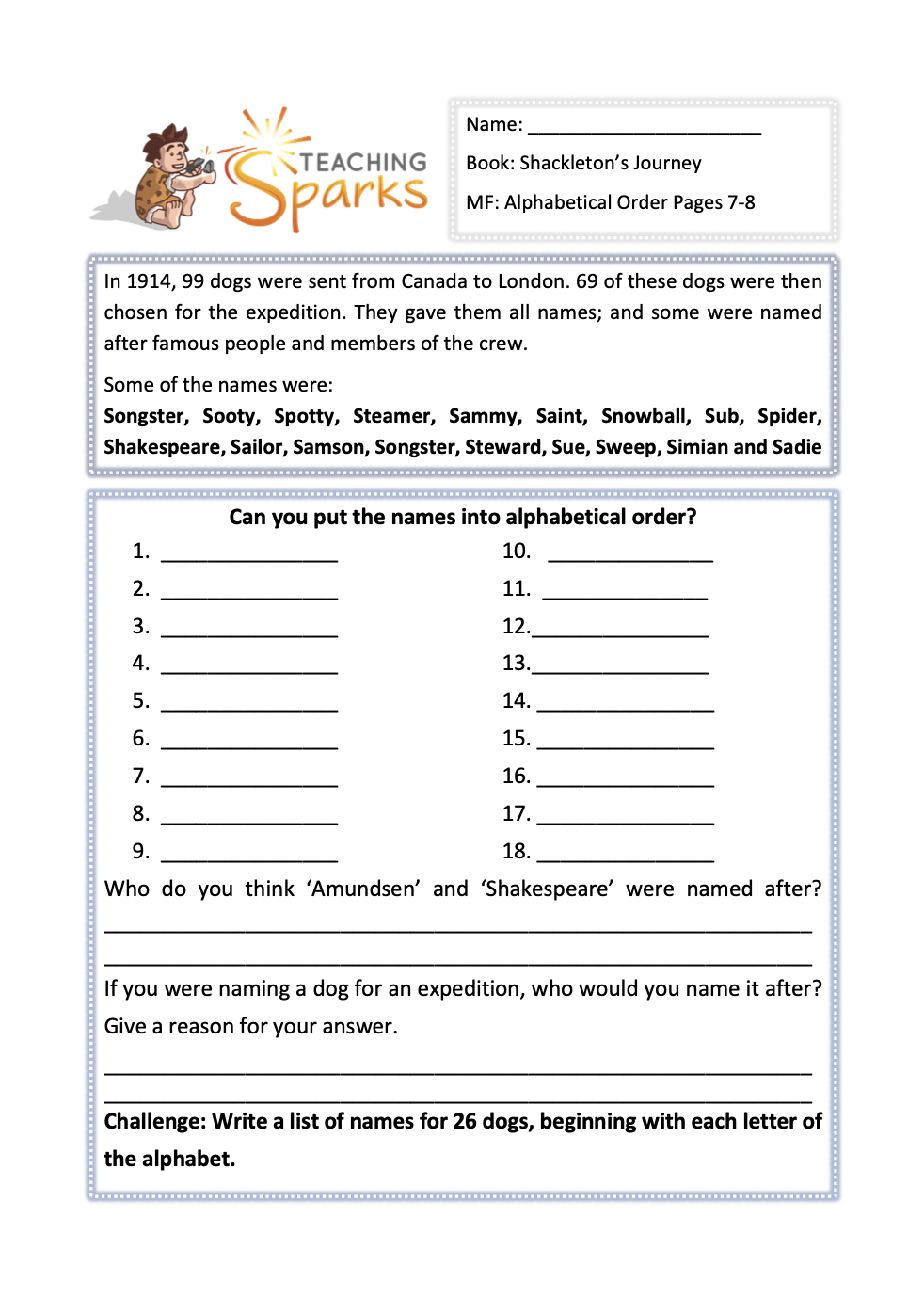
Main Focus: Alphabetical Order
This activity focuses on pages 7-8 of the book and alphabetical order.
In 1914, 99 dogs were sent from Canada to London. 69 of these dogs were then chosen for the expedition. They gave them all names; and some were named after famous people and members of the crew.
Some of the names were:
Wolf, Sooty, Paddy, Chips, Tim, Dismal, Bob, Martin, Hercules, Noel, Jamie, Alti, Jasper and Roy.
Your Year 3 / Year 4 class will put some of the names into alphabetical order.
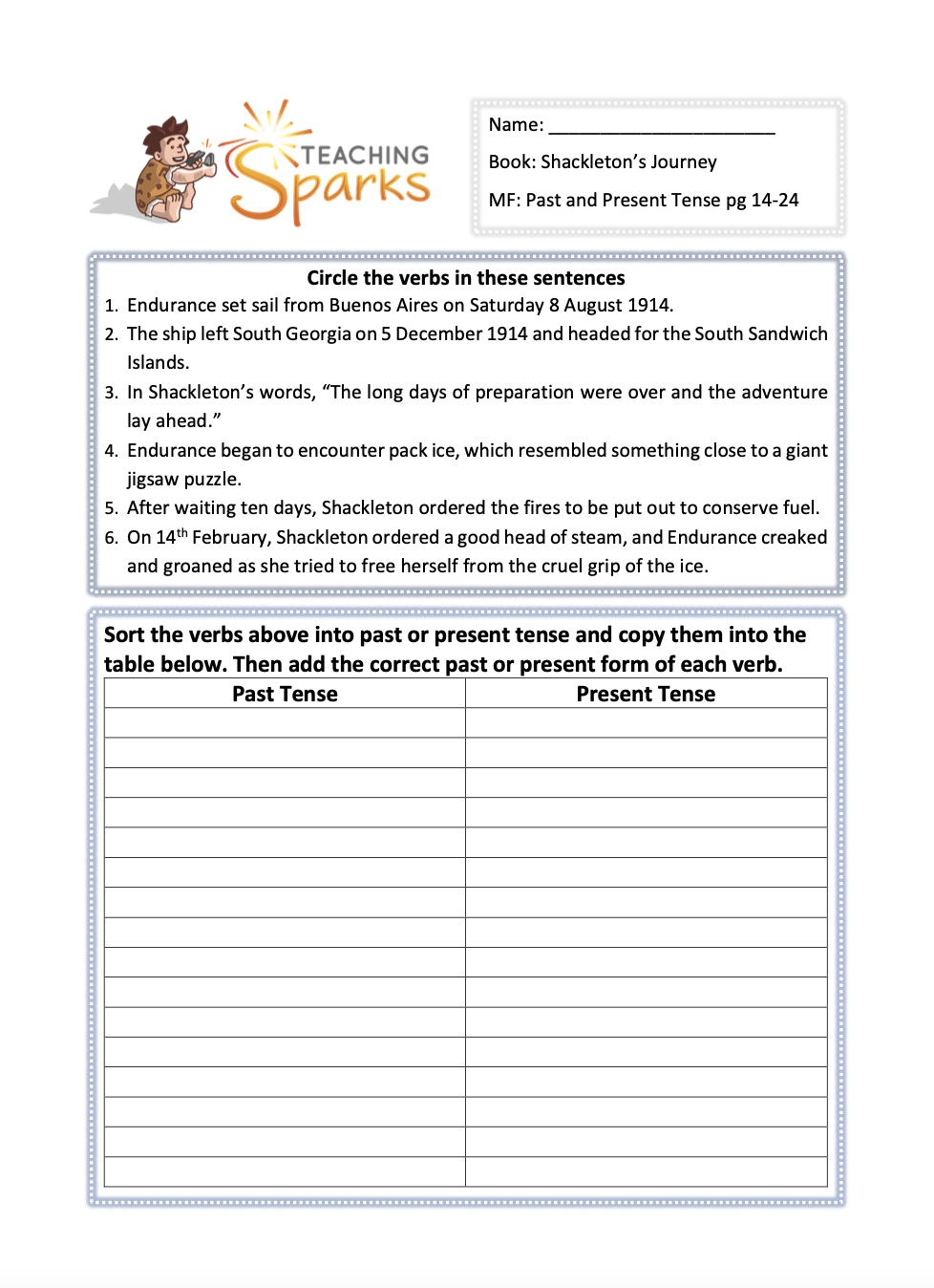
Main Focus: Past and Present Tense
This activity focuses on pages 14-24 of the book and tense.
Your LKS2 class will identify verbs in the sentences that have been chosen from the Shackleton’s Journey book and identify whether they are past or present tense.
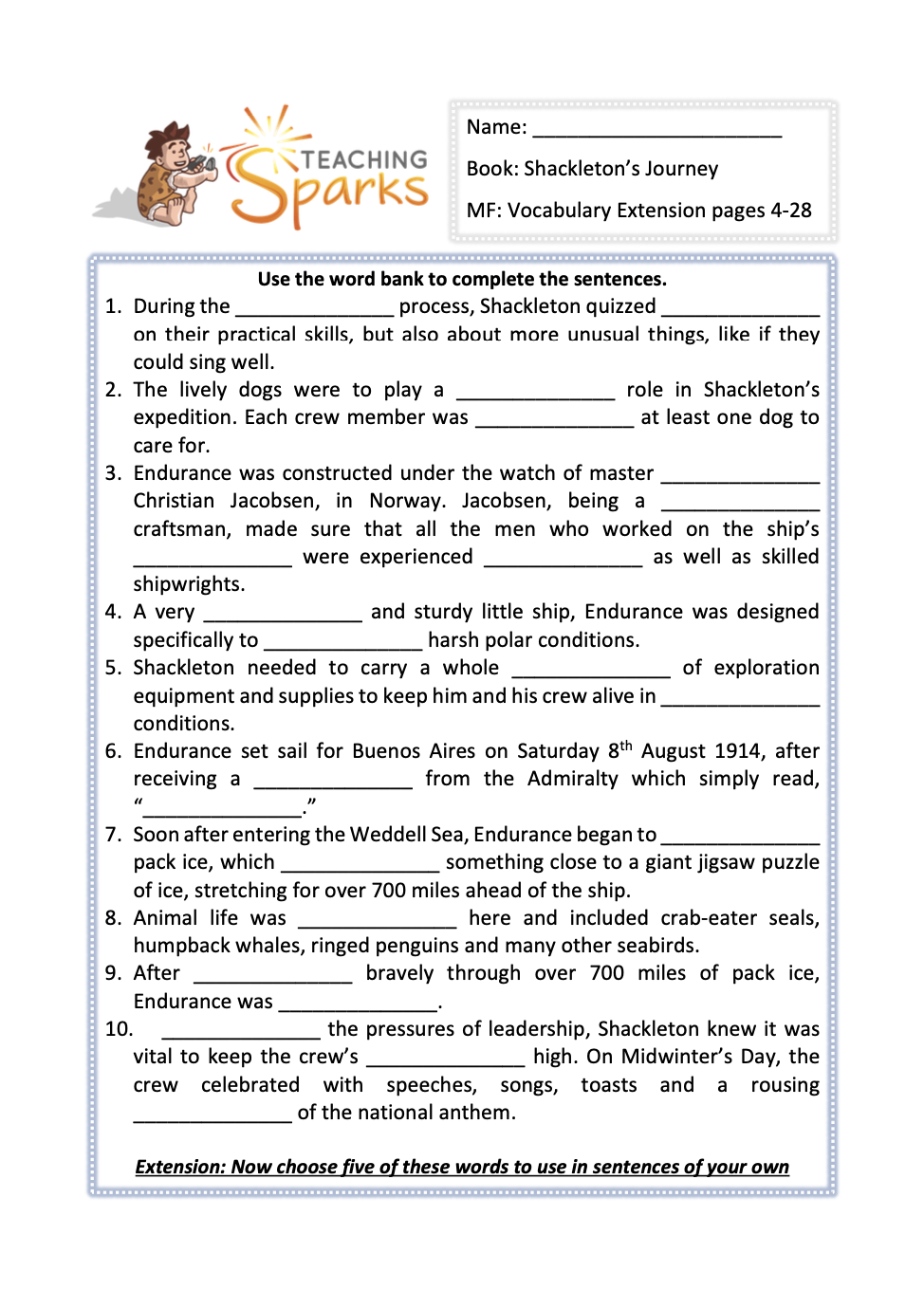
Main Focus: Vocabulary Extension - Pages 4-28
In this resource, your class will explore some of the challenging vocabulary from pages 4-28 of the book.
Your class will use the words bank to complete the sentences.
We have differentiated this a number of ways and your class can even do an extension activity of looking up definitions, synonyms, antonyms etc.
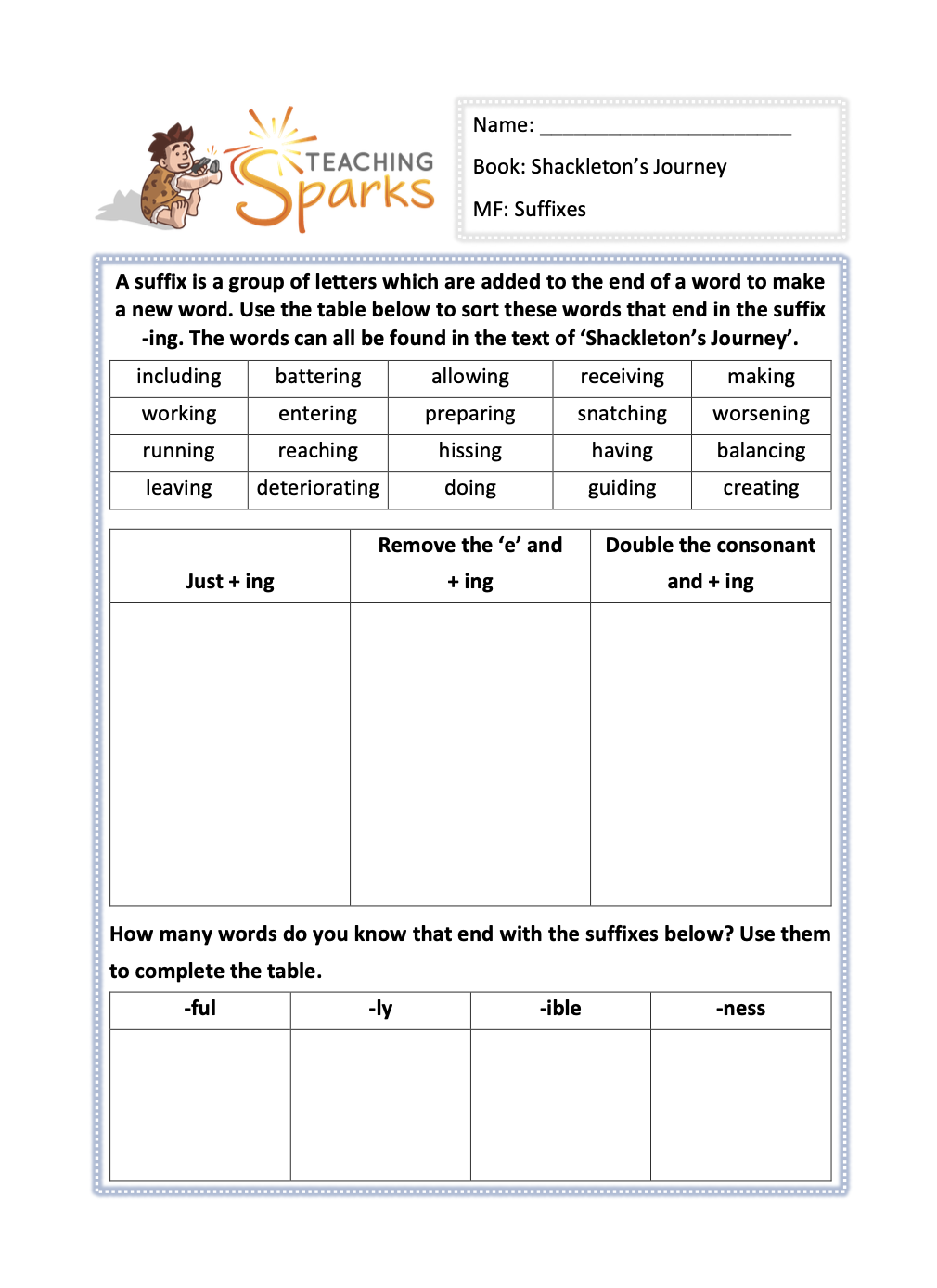
Main Focus: Suffixes
This resource focuses on suffixes: -ing, -ful, -ly, -ible & -ness
A suffix is a group of letters which are added to the end of a word to make a new word. Your class will use the table in the resource to sort the words that end in the suffix -ing.
The words can all be found in the text of ‘Shackleton’s Journey’.
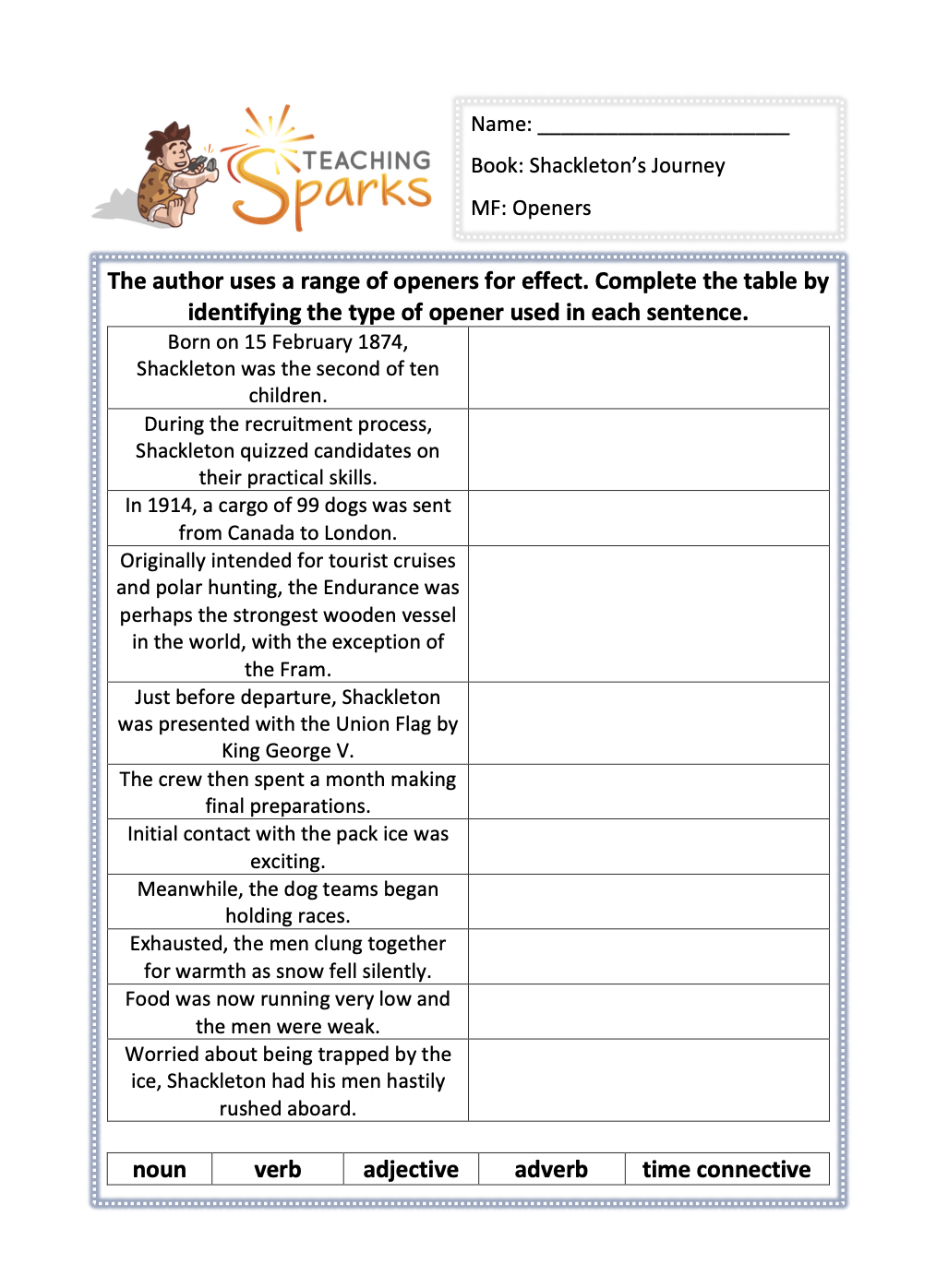
Main Focus: Sentence Openers
This LKS2 activity focuses on a range of sentence openers from the book.
Your class will begin to recognise the different openers used by the author by categorising them.
By recognising that there are different openers they can use, this will improve their literacy understanding and they can apply it to their independent writing.
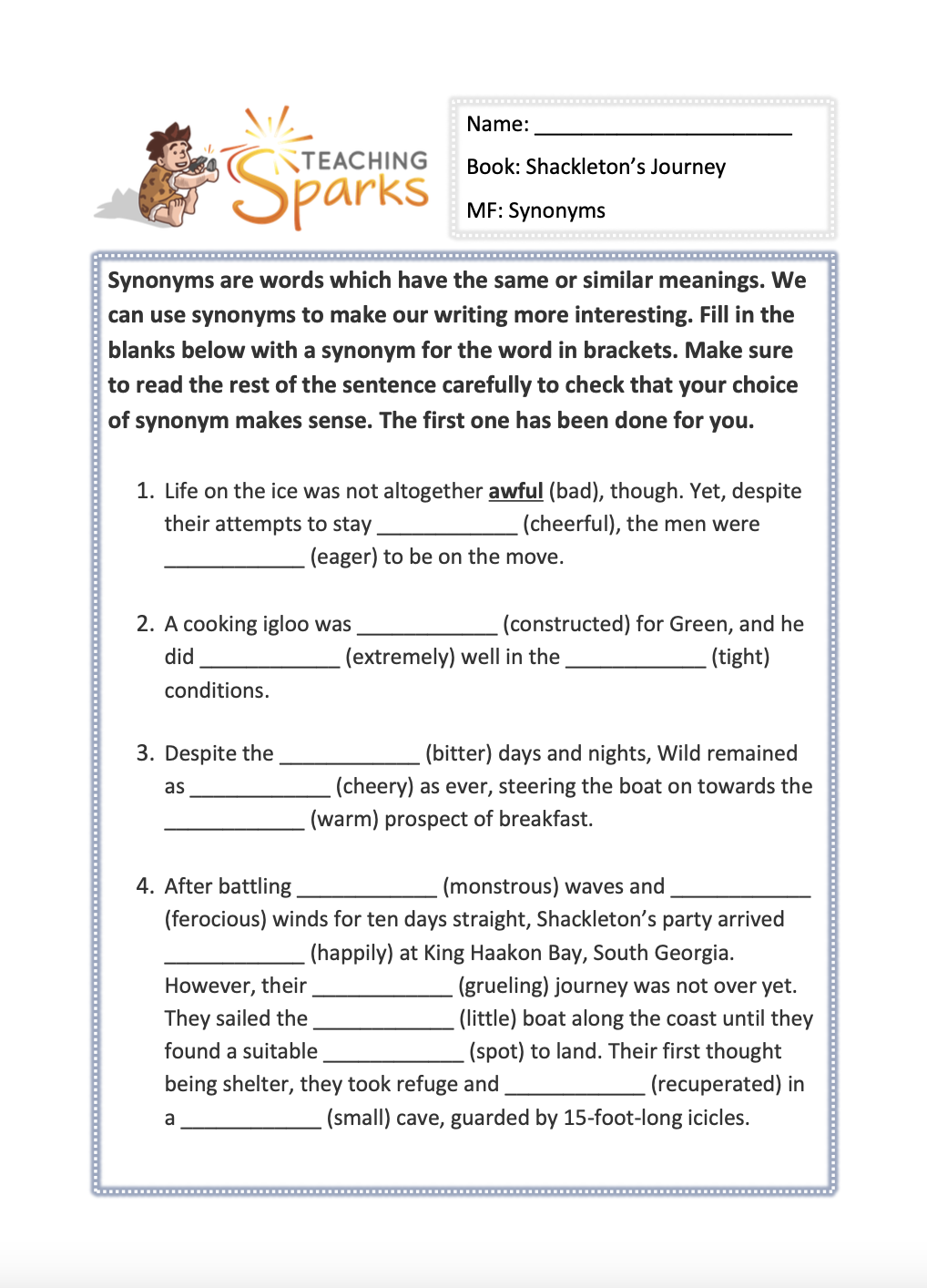
Main Focus: Synonyms
Synonyms are words which have the same or similar meanings. We can use synonyms to make our writing more interesting.
In this whole class reading / guided reading activity, tour class will fill in the blanks in the resource with a synonym for the word in brackets.
Make sure to remind them to read the rest of the sentence carefully to check that their choice of synonym makes sense. The first one has been done for them.
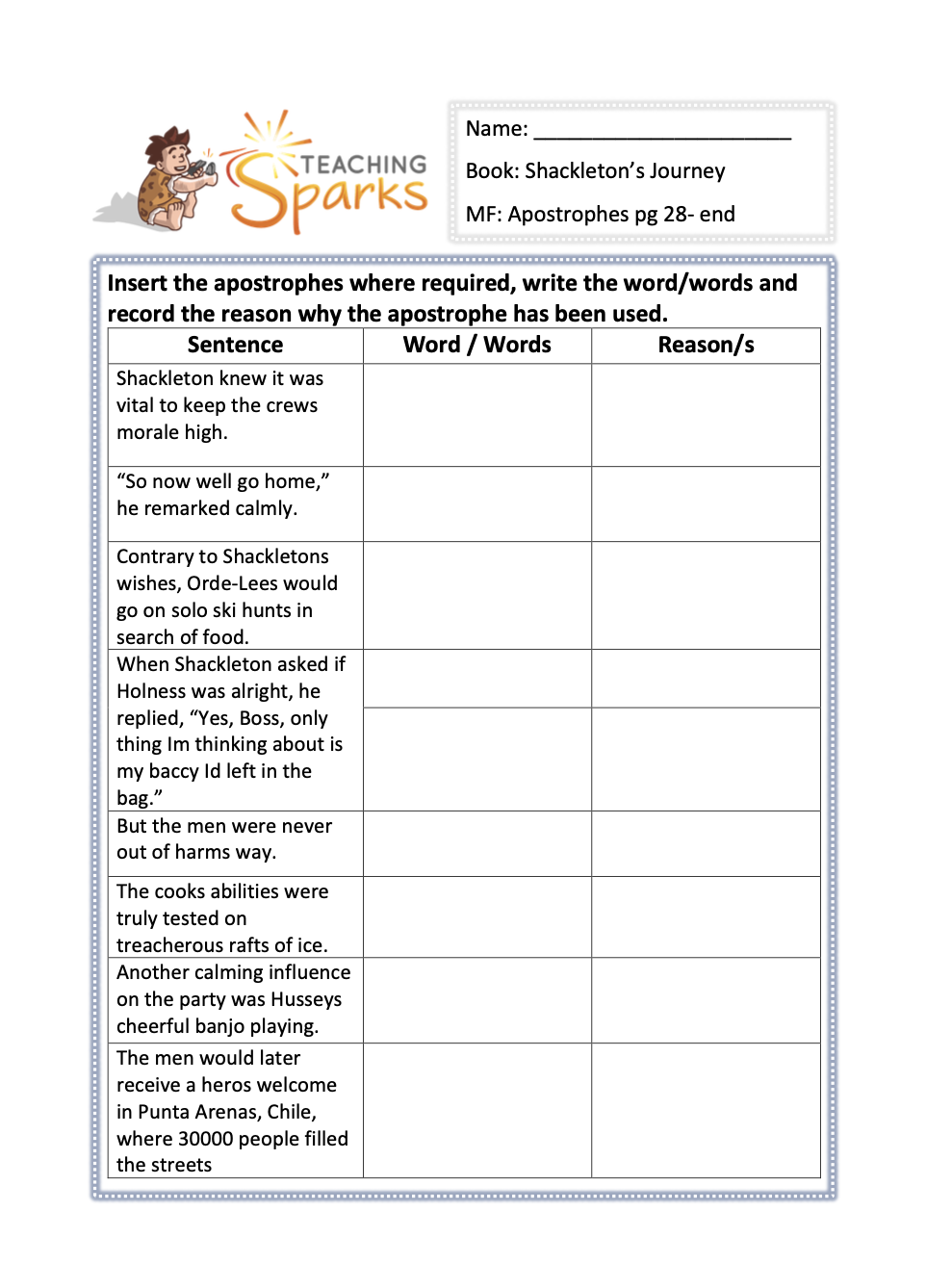
Main Focus: Apostrophes
This activity focuses on apostrophes and is from Page 28 of the book to the end.
This resource covers apostrophes for possession and contractions.
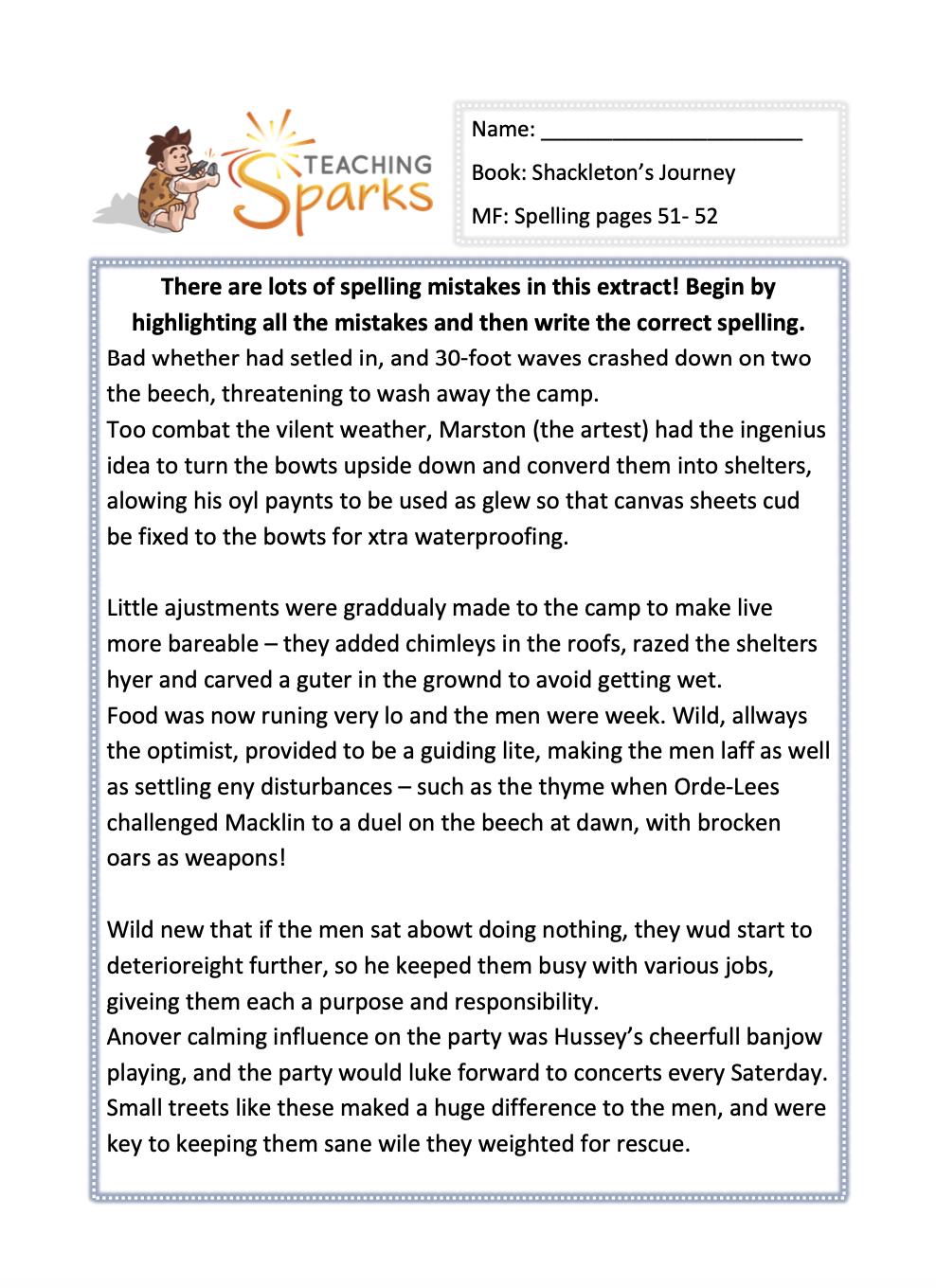
Main Focus: Spelling and Applying (including homophones)
This resource is linked to pages 51 and 52 of the book and spelling.
Your class are tasked to find all the spelling errors in the passage and then write the correct spelling of each word above.
We have also included homophones in this activity to help children identify words with different spelling and meanings, to help them put such words into the correct context.
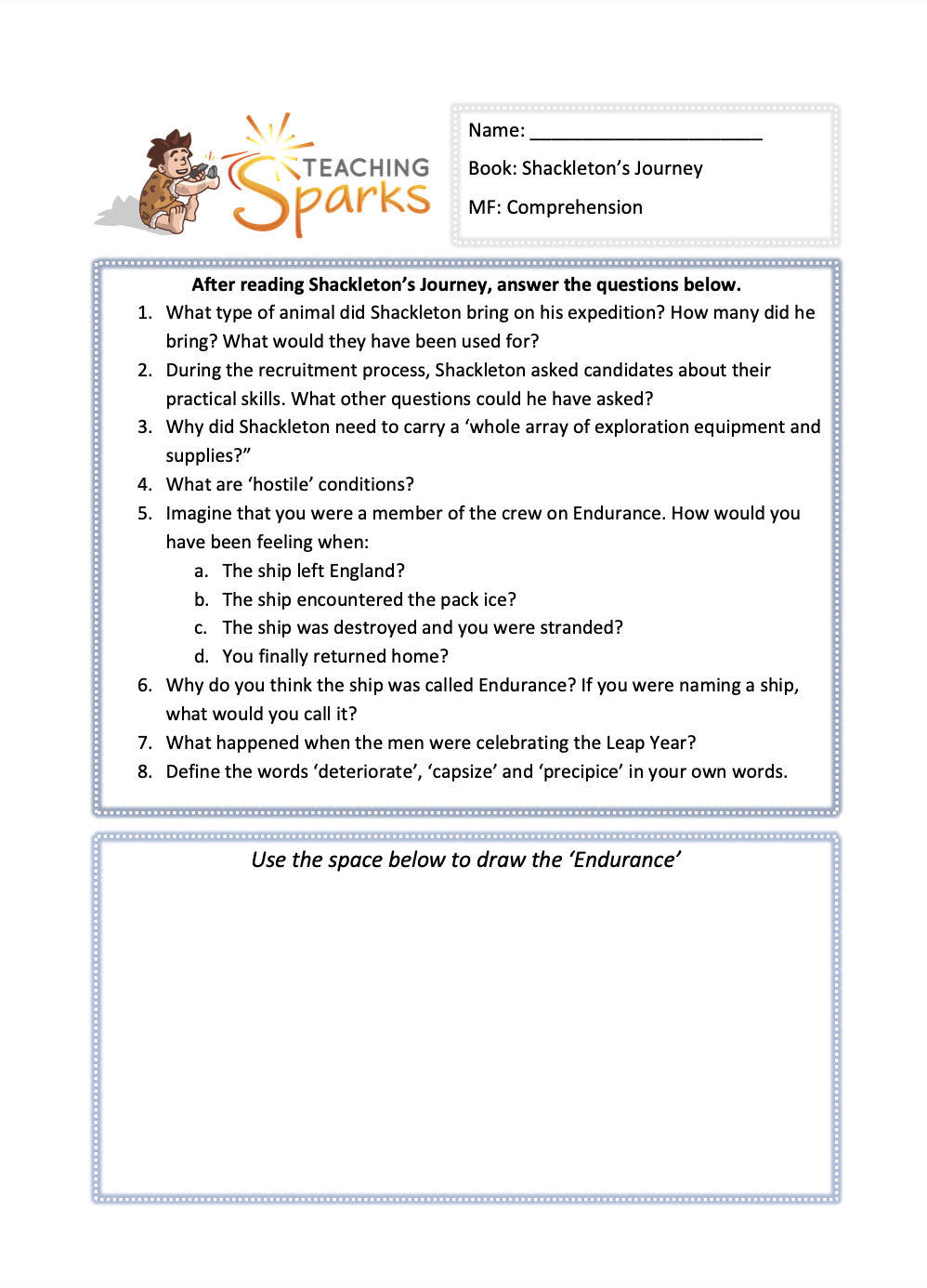

Main Focus: Comprehension
This is a comprehension for the book Shackleton’s Journey and focuses on the whole book.
Your Year 3 / Year 4 class will be encouraged to use their knowledge of the story, their understanding and apply their knowledge to answer the questions.
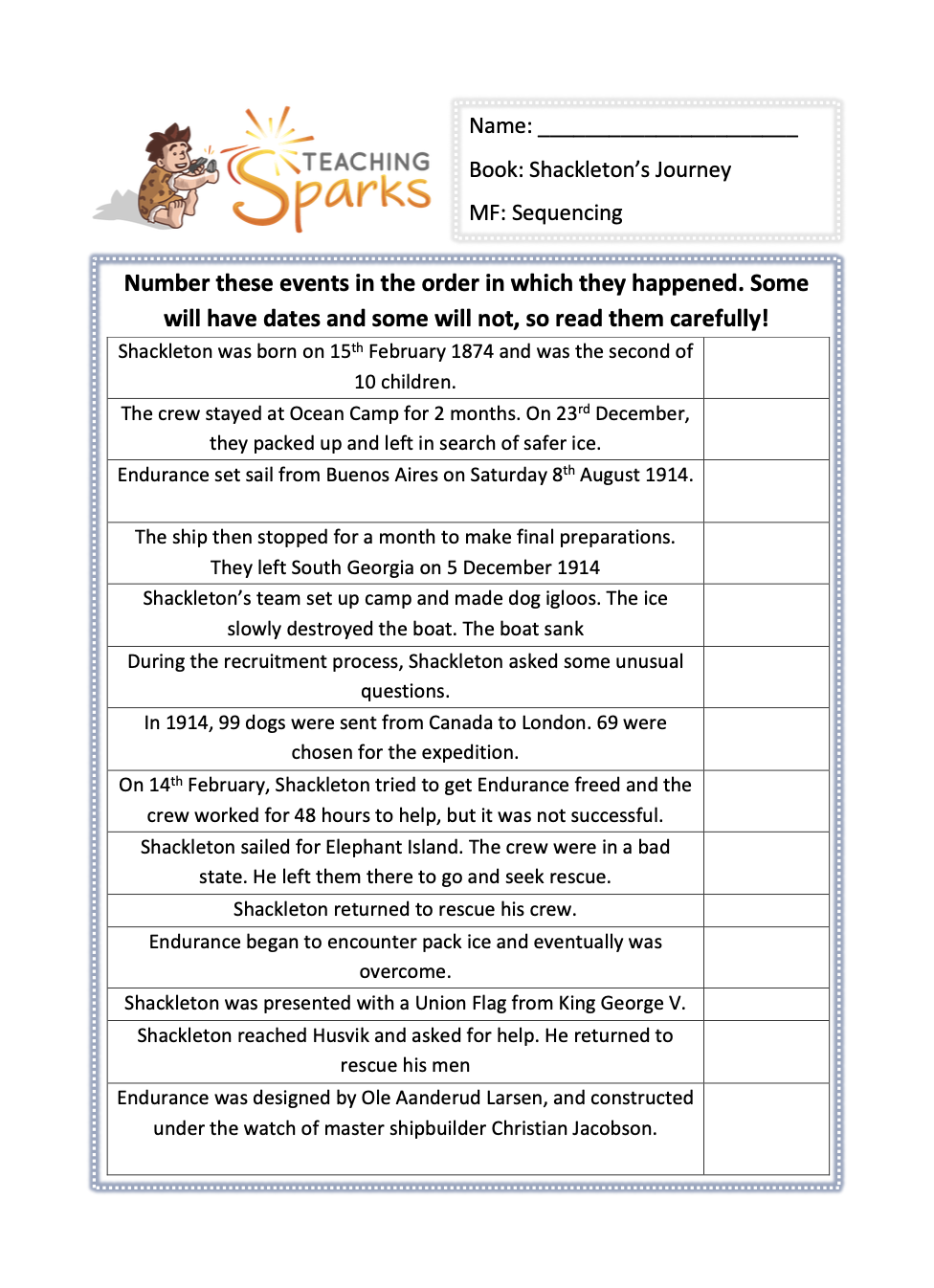
Main Focus: Event Sequencing
In this activity, your class will sequence the main events from the story in chronological order to show their understanding.
Your Year 3 / Year 4 class will number each event from 1-14 to complete the story sequence.
We use necessary cookies that allow our site to work. We also set optional cookies that help us improve our website.
For more information about the types of cookies we use, and to manage your preferences, visit our Cookies policy here.
Storybook cross-curricular planning example: Shackleton’s Journey
Added 03 Jul 2017 | Updated 24 Aug 17
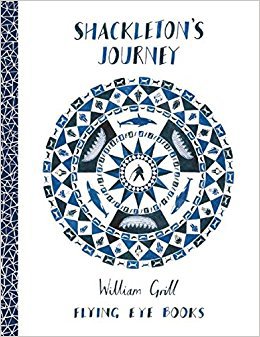
This resource demonstrates how to plan a whole school immersion in a quality text to inspire and motivate reading and writing for real purpose and audience. The book chosen is the wonderful Shackleton’s Journey by William Gill, although the same principles could be applied to any text.
Download files
You might also be interested in.
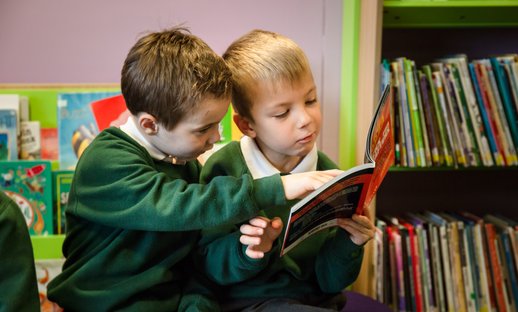
Share this article
- International
- Education Jobs
- Schools directory
- Resources Education Jobs Schools directory News Search

'Shackleton's Journey' by William Grill - Whole Class Reading
Subject: English
Age range: 7-11
Resource type: Lesson (complete)
Last updated
14 November 2021
- Share through email
- Share through twitter
- Share through linkedin
- Share through facebook
- Share through pinterest

Whole Class Reading Ppts for the book ‘Shackleton’s Journey’ by William Grills.
A total of 11 Powerpoints altogether with question slides focusing on DERIC reading model.
Slide sequence;
- Match synonyms
- Ready-to-print question slide
Also included is a short SATs style reading assessment which can be used at the conclusion of the book.
Tes paid licence How can I reuse this?
Your rating is required to reflect your happiness.
It's good to leave some feedback.
Something went wrong, please try again later.
This resource hasn't been reviewed yet
To ensure quality for our reviews, only customers who have purchased this resource can review it
Report this resource to let us know if it violates our terms and conditions. Our customer service team will review your report and will be in touch.
Not quite what you were looking for? Search by keyword to find the right resource:

Five Elements of Shackleton’s Leadership

I want to introduce you to an amazing leader. I have never met him and neither have you. He died in 1922. His most amazing accomplishment happened 100 years ago. This leader is Sir Ernest Shackleton. He led 27 men on a journey to be the first to cross Antarctica. He failed. Why do we care about a leader whose expedition failed? Because what happened instead was incredible.

On his third Antarctic expedition, Sir Ernest Shackleton led the Imperial Trans-Antarctic Expedition for Britain, which departed England in 1914. The plan was to sail his ship, the Endurance, to Argentina, then on to Antarctica, then walk across the continent where another crew would pick them up. Sounds simple. To put things in context keep in mind there were no radios, no weather reports, no Gore-Tex or snowmobiles, no lightweight nylon/down North Face jackets. The mission was lofty. But, Shackleton had the experience, an excellent crew, and the best 1914 gear he could get.
After leaving Argentina, the ship stopped at a whaling station on South Georgia Island. There they learned that the Weddell Sea, the most dangerous sea in the world, was jammed with ice, the worst in recorded history. Some of the whalers encouraged Shackleton to wait until next year. Shackleton spent a month at the whaling station hoping the situation would improve. Unfortunately, it didn’t. On December 5, 1914 Shackleton finally proceeded down to Antarctica. As you might have predicted, only six weeks later their ship was stuck in ice. One crew member described it as “frozen, like an almond in the middle of a chocolate bar.”
The crew made heroic efforts to free the ship. They tried to cut through the ice, but hours and hours of work was never enough. They were over 1,000 miles from any other humans and no one knew their predicament. They finally settled in for a long winter. They could only hope the spring would bring warmer temperatures and free their ship. For 10 months they waited. The cold, the ice, and the food supply were all concerns and the men began hunting seals and penguins to supplement their diet. However, Shackleton’s biggest concern was demoralization of the crew. He was intentional to keep the men’s spirits high. He encouraged singing, games, and skits in the evenings. He listened to them and had an “open-door policy” long before that phrase was coined. He had all the men cross-train in various roles to increase their stimulation and their competence. Surprisingly, during the 10 months their ship was stuck in the ice, the men were content. One man wrote in his journal after a particular celebration that it was “one of the happiest day of my life.”
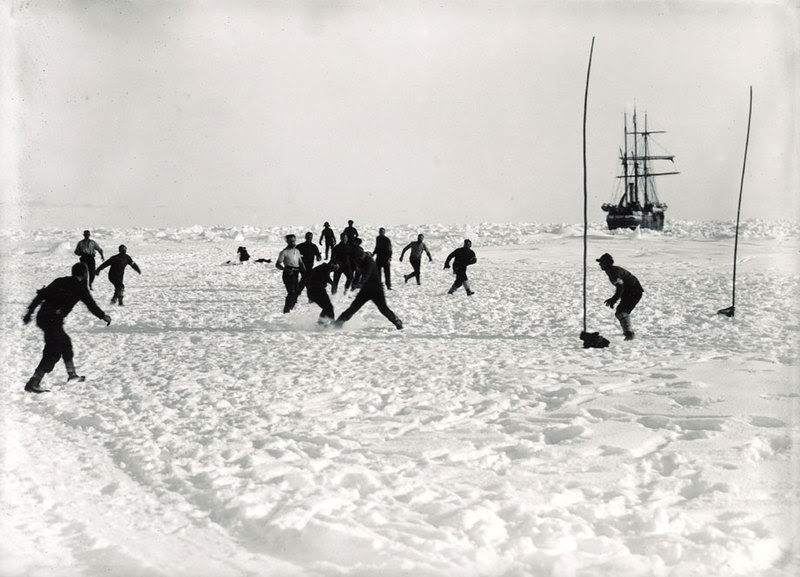
Then, on October 24, 1915, things got much worse. The ice shifted and started to crush the ship. It was soon pitched to the side and men had to move off the ship onto the ice. They started unloading the ship preparing for the worst. Three weeks later the ship sunk and the 28 men were stuck on an ice flow in Antarctica with nothing but three small lifeboats and a pile of gear. No one knew where they were and back in England they were presumed to be dead.
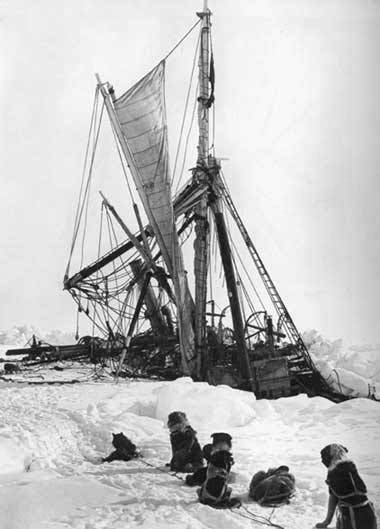
Shackleton’s journey was amazing. The early 1900’s was the age of polar expeditions. It was common for men to die during the journey. Shackleton would not accept death. He used a systems approach to create a strong team that could handle the difficult situations they faced. It may have been my own experience with expeditions as an Outward Bound instructor and a sea kayak guide that first sparked my interest in Shackleton’s story. I now give keynotes and workshops on his leadership style, most recently for the National Conference for State Legislators . Here are the leadership lessons share in the keynote.
- Model and Inspire Optimism: Shackleton believed in his mission and in his team. His optimism was contagious. He intentionally made decisions to inspire optimism in his crew. He was enthusiastic, clear in his vision. He encouraged singing, games, fun antics, and other merriment during the expedition.
- Develop a Clear, Shared Purpose: Everyone who joined the Antarctic Expedition understood the purpose. They were selected, in part, for their interest and excitement in that purpose. Many times teams form and their purpose is somewhat vague or each team member has a different idea of that purpose. Clarity around purpose has been shown, time and again, to be the most important factor to impact a team’s success.
- Build Unity and Commitment Within the Team: Shackleton valued hard-work and loyalty above all else. Yet, he didn’t expect this automatically; he intentionally fostered it. The team’s well-being was his top priority, higher than his mission. He knew without the team, they could never reach their goal. He got to know each team member personally and understood their strengths and their style. He made sure team members could come to his with concerns and had an “open-door policy” long before the term was coined.
- Create a Plan, an Alternate Plan, and Be Flexible: After the team left Patience Camp they traveled in three life boats searching for land, which they hadn’t seen in 15 months . During the 15 day journey, Shackleton changed the plan four times. The change was always because new information emerged and he had to adjust in order to meet the end goal. He avoided getting emotionally attached to a particular plan, no matter how much time he had spent devising it.
- Make the Tough Decisions: Shackleton continually made difficult decisions throughout the expedition. He would have been terribly unpopular among the crew had he not build relationships and loyalty. He always made decisions with their best interest in mind. For instance, when the ship arrived in Argentina after crossing the Atlantic, the cook got drunk and disorderly one night. He was fired. Shackleton did find him a new job on a ship heading to England though. Shackleton knew that man was not a good fit for his team. He then hired a new cook who proved to be an excellent addition.
Shackleton was heralded by his team as being “the greatest leader on Earth.” Wow. To implement just one element of his leadership will be valuable. Looking at this list what is one thing, even if small, that you could do this week to better lead your team?
I hope you will find inspiration, as I did, from this amazing leader.
If you want to read more about Shackleton, I recommend the books Endurance and Shackleton’s Way . You might also enjoy this episode about Shackleton on the Deliberate Creative Podcast .
Summary of Shackleton's Leadership Principles

Subscribe to download the summary page of Shackleton's Leadership Principles. You will also receive occasional articles about creativity and teams and exclusive offerings.
Success! Now check your email to confirm your subscription.
There was an error submitting your subscription. Please try again.
Dr. Amy Climer
Leave a replay, about amy climer.
Creative, open, and inspiring, Dr. Amy Climer brings her passion and energy to every group she facilitates. She has over 20 years of experience leading and facilitating teams, designing and delivering leadership development programs, and teaching teams to be more innovative. Amy blends her background in experiential outdoor education with the fields of creativity, leadership and change to lead robust, interactive programs.
Recent Posts

18 Best TED Talks for Team Building

6 Top Team-building Facilitators In The Milky Way (Mainly Earth)

Build a Vibrant Culture: Unleashing Your Team’s Creativity

The Selling Show: Sales Creativity

IACC Set Sights on Creative Innovation During Knowledge Exchange
Creativity resources.

300+ Uses for a Nalgene Bottle: The Creativity Doctor’s 300+ Uses Series by Daniel Cape PhD

The Innovative Team: Unleashing Creative Potential for Breakthrough Results by Chris Grivas & Gerard Puccio

Your Creative Power by Alex Osborn

From Experience to Creativity: The Experiential Educator’s Incomplete Guide to Creativity by Daniel Cape

Designing Your Life: How to Build a Well-Lived, Joyful Life by Bill Burnett and Dave Evans
Recent podcast.

Episode 103: Designing Creative Space with Donald Rattner

Episode 102: Emergent Innovation with Johnathan Cromwell

Episode 101: Polymaths with Dr. Angela Cotellessa

Episode 100: Creativity Stories from Listeners

Episode 99: How to Conduct Ethnographic Interviews for Design

Get your free Climer Cards Activity Guide
Download your free Climer Cards Activity Guide packed with new team activities to use with your Climer Cards. You will also receive free monthly articles about creativity and teams, podcast and blog posts, and occasional exclusive offerings.
Hire Dr. Amy Climer
Fill in the form below and our team will be happy to assist you
Find out why teachers and school leaders love PlanBee
- 📚 Cross-Curricular Topics
- ✂️ Design & Technology
- ♻️ Education for Social Responsibility
- 🌍 Geography
- ⛪️ Religious Education
- 🎉 Special Days
- 🦸♀️ Special People
- Vision and Principles
- Our Curriculum Offer
- Curriculum Packs
- Become a School Subscriber
- FREE Schemes of Work
- Sample Packs
- Learn at Home
- Objective Checker
- How does it work?
Shackleton's Journey Letter Writing
What's Your Email?
Are your children ready for adventure? Are they prepared to journey through hazardous conditions and to face constant danger? Are they driven by honour and duty? Great, then this Shackleton's Journey KS2 Planning Pack based on the breath-takingly beautiful book by William Grill is for you! Please be aware that, for copyright purposes, we are unable to provide the full text for this scheme of work.
#TheCompleteSeries6lessons
In this series of six lessons, children will read the introduction to Shackleton's Journey and imagine themselves as pioneering crew members of the Endurance, bound for their historic mission to Antarctica. To begin the unit, children will use high-quality model texts to identify the key features of effective letter writing and carry out their own research into given crew members. They will become fully immersed in their character as they imagine themselves in a series of challenging scenarios in the uncharted seascape and landscape of Antarctica. Through games, oral rehearsal, sentence exploration and well-structured, differentiated resources, children will become confident with using the subjunctive form and creating cohesion within and across paragraphs. In the final part of the unit, your Year 6 class will plan, draft and edit an effective letter of application to join Shackleton's crew.
Looking for cool, polar-themed resources? You might be interested in our free polar writing frames - perfect for your children to write their own stories full of adventure and adversity, design ships for the most challenging Antarctic expeditions and much more.
#Lesson1Keyfeaturesofformalletters
This first lesson, inspired by 'Shackleton's Journey', encourages children to reflect on the Heroic Age of Polar Exploration and the world of 1914 before asking them to consider whether they have what it takes to be a polar explorer and how they might apply for a position onboard Shackleton's Endurance.
Your Year 6 class will look in detail at the key features of an effective letter of application and formal language choices. They will analyse a good quality application letter from expedition artist, George Marston, and identify the key features within the text. By the end of the lesson, your Year 6 class will have a solid understanding of the key features of effective letter writing which they can use as an anchor when they come to write their own letter of application.
This letter-writing Year 6 Lesson Pack is ready to teach, with a detailed lesson plan, engaging slides for input and differentiated activities.
What's included:
- Lesson Plan
- Activity ideas
- Differentiated worksheets
#Lesson2Researchingandnotetaking
Children are invited to dive right into the unit by choosing and researching the trail-blazing crew member they would like to write as.
After exploring the roles needed to successfully undertake such an ambitious, historic mission, children will use the Biography Cards provided to research a given crew member (e.g. Frank Worsley, Captain). Your class will select key information about the qualities and experience that make them the perfect fit for this Antarctic expedition and record summary notes which outline ideas for their application letter.
Everything you need to teach this absorbing lesson is included in the pack including: a detailed lesson plan, engaging slideshow and all the printable resources you need.
- Biography cards
- Differentiated note sheets
#Lesson3Thesubjunctiveform
In this highly-interactive session, children will get to grips with the different variants of the subjunctive form - from describing imaginary or hypothetical situations to expressing urgent and compulsory requests.
Children will imagine themselves in different roles and hypothetical situations and decide what they would do in each scenario. Trouble at sea? Engine failure? No problem! If I were your crew member, you could rely on me. After plenty of oral rehearsal, children will experiment with using the subjunctive form, creating a variety of sentences to suit their proposed hypotheticals. Alternatively, you might like to invite children to play the entertaining yet unpredictable game, Kaboom! Who knew learning the finer points of grammar could be this much fun?
This Year 6 Lesson Pack contains everything you need to identify and use the subjunctive form including: a detailed lesson plan, engaging slideshow and printable, differentiated worksheets.
- Kaboom! cards
#Lesson4Buildingcohesion
In this lesson, children will learn about the importance of cohesive devices when writing a clearly structured and engaging letter.
Here, children will focus on paragraphing, adverbials and conjunctions to link ideas, pronouns, synonyms and punctuation. They will use their understanding of these devices to recreate letters from two keen expedition applicants which have been scrambled together.
Everything you need to teach this exciting lesson is included in the pack including: a detailed lesson plan, engaging slideshow and all the printable resources you need.
- Differentiated scrambled sentences and letter templates
#Lesson5Planninganapplicationletter
It's time to bring all of the content that the children have been working on together in one fantastic plan! In this lesson, children will discuss the purpose, structure and content of effective paragraphs to give them all the skills they need to create a compelling plan for their letter of application. Shackleton will be left in no doubt that these applicants are the men for the job!
The slideshow will walk your children through the process of constructing clear, well-structured paragraphs organised around relevant themes and there are plenty of modelled paragraphs which offer children the opportunity to develop ideas for their own letter. Using their very own Paragraph Planner, children will create opening topic sentences before adding supporting details and explanatory ideas which link to a key theme.
This letter-writing Year 6 Lesson Pack is ready to teach, with a detailed lesson plan, engaging slides for input and differentiated activities, all at the click of a button.
- Differentiated planners
- Biography Cards
#Lesson6Writingandeditinganapplicationletter
Your Year 6 class are now ready to make their application! In this final lesson, children will put into practice everything they have learnt about effective letter writing.
After recapping the layout and structure of formal letters, children will use their plan to write in role as a potential crew member aboard the Endurance. At the end of the lesson, children will review each other's letters to decide who are the most suitable candidates to join the expedition team.
This letter-writing Year 6 Lesson Pack contains everything you need to produce an effective letter of application including: a detailed lesson plan, engaging slideshow, as well as printable, differentiated writing frames and checklists.
- Differentiated writing frames and checklists
Free Overview (Medium-Term Plan)
Download a free overview to support your teaching of this scheme of work.
Free Assessment Grid
Download a free, editable assessment grid to support your teaching of this scheme of work.
Curriculum Objectives covered
Reading - comprehension objectives:.
- continuing to read and discuss an increasingly wide range of fiction, poetry, plays, non-fiction and reference books or textbooks
- reading books that are structured in different ways and reading for a range of purposes
- increasing their familiarity with a wide range of books, including myths, legends and traditional stories, modern fiction, fiction from our literary heritage, and books from other cultures and traditions
- checking that the book makes sense to them, discussing their understanding and exploring the meaning of words in context
Writing - Transcription Spelling Objectives:
- use dictionaries to check the spelling and meaning of words
- use the first three or four letters of a word to check spelling, meaning or both of these in a dictionary
- use a thesaurus
Writing - Composition Objectives:
- identifying the audience for and purpose of the writing, selecting the appropriate form and using other similar writing as models for their own
- noting and developing initial ideas, drawing on reading and research where necessary
- selecting appropriate grammar and vocabulary, understanding how such choices can change and enhance meaning
- using a wide range of devices to build cohesion within and across paragraphs
- assessing the effectiveness of their own and others’ writing
- ensuring the consistent and correct use of tense throughout a piece of writing
- ensuring correct subject and verb agreement when using singular and plural, distinguishing between the language of speech and writing and choosing the appropriate register
- proof-read for spelling and punctuation errors
Writing - Spelling, Punctuation and Grammar Objectives:
- recognising vocabulary and structures that are appropriate for formal speech and writing, including subjunctive forms
- using expanded noun phrases to convey complicated information concisely
- using semi-colons, colons or dashes to mark boundaries between independent clauses
- using a colon to introduce a list
- The difference between structures typical of informal speech and structures appropriate for formal speech and writing [for example, the use of question tags: He’s your friend, isn’t he?, or the use of subjunctive forms such as If I were or Were they to come in some very formal writing and speech]
Spoken Language Objectives:
- The difference between vocabulary typical of informal speech and vocabulary appropriate for formal speech and writing [for example, find out – discover; ask for – request; go in – enter]
- How words are related by meaning as synonyms and antonyms [for example, big, large, little].
- listen and respond appropriately to adults and their peers
- use relevant strategies to build their vocabulary
- articulate and justify answers, arguments and opinions
- maintain attention and participate actively in collaborative conversations, staying on topic and initiating and responding to comments
English Appendix Objectives:
- speak audibly and fluently with an increasing command of Standard English
- participate in discussions, presentations, performances, role play/improvisations and debates
- gain, maintain and monitor the interest of the listener(s)
- consider and evaluate different viewpoints, attending to and building on the contributions of others
- select and use appropriate registers for effective communication
Customer Reviews
I love all your units- the content, resources and slides. Will be looking forward to this new unit in October.
Thank you for your kind words, Susan! We hope that you and your class enjoy these resources :-)
Added to your cart:
Let customers speak for us.
Great resources, easy to use & all children engaged
We're so pleased that you are happy with your subscription, Julie - thank you for taking the time to leave us a review!
SAMPLE RE Lessons from Year 1 to Year 6
Thanks, Becky!
Great resource as usual. Has everything I need and saved me precious time x
We're so pleased to hear that our resources have saved you time, Claire!
FREE Mini-Scheme: Ocean Animals
Hi Jane, thank you for leaving a review for our FREE Mini-Scheme: Ocean Animals! We're sorry to hear that you gave it a one-star rating - please feel free to reach out to us with any feedback at [email protected] .
Great visual resource. Would be good to have on PowerPoint to edit to meet all of my schools objectives.
Thank you for your feedback about our resources. We use PDFs to ensure that everyone can access them, no matter what version of software they have. We have sent you an email with further details on some free PDF readers and editors - we hope this helps! If we can assist you any further, you can contact us at [email protected]
Home — Essay Samples — Literature — Plot — The Hero’s Journey in J.R.R. Tolkien’s “The Hobbit”
The Hero's Journey in J.r.r. Tolkien's "The Hobbit"
- Categories: Plot The Hobbit
About this sample

Words: 572 |
Published: Jun 6, 2024
Words: 572 | Page: 1 | 3 min read
Table of contents
Introduction, body paragraph 1: the call to adventure, body paragraph 2: crossing the threshold and trials, body paragraph 3: the transformation and atonement.

Cite this Essay
Let us write you an essay from scratch
- 450+ experts on 30 subjects ready to help
- Custom essay delivered in as few as 3 hours
Get high-quality help

Dr. Karlyna PhD
Verified writer
- Expert in: Literature

+ 120 experts online
By clicking “Check Writers’ Offers”, you agree to our terms of service and privacy policy . We’ll occasionally send you promo and account related email
No need to pay just yet!
Related Essays
2.5 pages / 1190 words
2.5 pages / 1183 words
3.5 pages / 1598 words
1.5 pages / 801 words
Remember! This is just a sample.
You can get your custom paper by one of our expert writers.
121 writers online
Still can’t find what you need?
Browse our vast selection of original essay samples, each expertly formatted and styled
Related Essays on Plot
Flake, S. (2000). The Skin I'm In. Jump at the Sun.Freadman, A. (2019). Constructing Identity in Adolescent Fiction: The Skin I'm In and The House on Mango Street. Children's Literature in Education, 50(1), 49-63.Hayden, L. S. [...]
The turn of the eighteenth century is at the cusp of radical shifts in ideology, booming industry and scientific advancement for the Western World. The rapid changes, and growing middle class widens the audience for conduct [...]
This is the stop of season 1 episode six of Serial which describes the story of Mrs. Lee getting manually strangled and left in Leakin park alone, putting a boy in prison who later turned into a man, lost his childhood, claimed [...]
When pondering the daunting uncertainties of life, a man can only be sure that it will be filled with suffering. The tranquil and pleasant periods of life may give it the semblance of congeniality, but a person will always be [...]
“Regardless of what we might think of our gender, we can only live that gender through the body we have.” Throughout Sharon Pollock’s play Blood Relations, the plotline focuses on the life of Lizzie Borden and her [...]
Arthur Miller shows how 'The Crubicle' portrays fear through conformity and how we can relate that in our lives today. Conformity is a very strong form of fear and is portrayed all throughout 'The Crubicle'. Conformity has [...]
Related Topics
By clicking “Send”, you agree to our Terms of service and Privacy statement . We will occasionally send you account related emails.
Where do you want us to send this sample?
By clicking “Continue”, you agree to our terms of service and privacy policy.
Be careful. This essay is not unique
This essay was donated by a student and is likely to have been used and submitted before
Download this Sample
Free samples may contain mistakes and not unique parts
Sorry, we could not paraphrase this essay. Our professional writers can rewrite it and get you a unique paper.
Please check your inbox.
We can write you a custom essay that will follow your exact instructions and meet the deadlines. Let's fix your grades together!
Get Your Personalized Essay in 3 Hours or Less!
We use cookies to personalyze your web-site experience. By continuing we’ll assume you board with our cookie policy .
- Instructions Followed To The Letter
- Deadlines Met At Every Stage
- Unique And Plagiarism Free

IMAGES
VIDEO
COMMENTS
However, by breaking down the essential elements of Shackleton's journey into manageable planning points, you, too, can traverse the icy terrain and deliver. ... Have students write short paragraphs using several key vocabulary words from Shackleton's Journey, demonstrating their understanding of their meanings.
Shackleton's Journey: A Lovely Illustrated Chronicle of History's Most Heroic Polar Expedition By Maria Popova. In August of 1914, legendary British explorer Ernest Shackleton led his brave crew of men and dogs on a journey to the end of the world — the enigmatic continent of Antarctica. That voyage — monumental both historically and ...
Key learning points 'Shackleton's Journey' includes themes of leadership, resilience, hope and exploration. Shackleton is recognised as an excellent leader, who remained determined in the face of adversity.
Key learning points. 'Shackleton's Journey' is presented as a non-fiction picturebook text. The text chronicles the extraordinary Antarctic expedition led by Sir Ernest Shackleton in 1914. Antarctica is a vast and frigid continent located at the southernmost part of the Earth. Exploring the context of a text can allow readers to engage with it ...
Shackleton's Journey is a uniquely visual non-fiction re-telling of Ernest Shackleton's epic expedition across the Antarctic. The text has a clear factual style as well as sparse but thought-provoking illustrations by William Grill which are highly engaging. This gives children an understanding of the period after the Victorians and the ...
Building comprehension of 'Shackleton's Journey' through rich discussion. I can answer a range of comprehension questions on 'Shackleton's Journey'. 1 Slide deck. 1 Worksheet. 2 Quizzes.
Shackleton's Journey Discussion Points There is lots of variation in the size and shape of illustrations. How does this affect your reading experience? 'Journeying into the heart of Antarctica meant that Shackleton would need to carry a whole array of exploration equipment and supplies to keep him and his crew alive in hostile conditions,
Shackleton's Journey is the true story of how Shackleton and his crew managed to survive this epic adventure, and a testament to their great courage and endurance. Main Focus: Alphabetical Order. This activity focuses on pages 7-8 of the book and alphabetical order.
Storybook cross-curricular planning example: Shackleton's Journey. This resource demonstrates how to plan a whole school immersion in a quality text to inspire and motivate reading and writing for real purpose and audience. The book chosen is the wonderful Shackleton's Journey by William Gill, although the same principles could be applied ...
English - LKS2 - Shackleton's Journey Overview Text: Shackleton's Journey by William Grill Outcomes: Packing lists (justifications), letters (formal ... - Introduction to paragraphs as a way to group related material - Headings and sub-headings to aid presentation - Use of the present perfect form of verbs instead of the simple
His crew got within a scant 100 miles of the Pole - farther south than anyone had every gone before - when Shackleton was forced to turn back because of his crew's ill-health and their dwindling supplies. Three years later a Norwegian explorer named Roald Amundsen became the first man ever to reach the South Pole.
Just one day away from Antarctica, Shackleton's ship was crushed and destroyed. His ingenuity and bravery helped save the crew.
Building comprehension of 'Shackleton's Journey' through rich discussion. I can answer a range of comprehension questions on 'Shackleton's Journey'. Download all resources. Share activities with pupils.
In this set based on Shackleton's Journey by William Grill you'll find ideas to support spoken language, reading, writing, grammar, vocabulary and spelling. This Starting Points resource will give you everything you need to plan a beautiful book-based unit of work for children in Year 5 and Year 6. In additional to extensive ideas to ...
Whole Class Reading Ppts for the book 'Shackleton's Journey' by William Grills. A total of 11 Powerpoints altogether with question slides focusing on DERIC reading m
Here are the leadership lessons share in the keynote. Elements of Shackleton's Leadership: Model and Inspire Optimism: Shackleton believed in his mission and in his team. His optimism was contagious. He intentionally made decisions to inspire optimism in his crew. He was enthusiastic, clear in his vision.
Transform your class into pioneering polar explorers with this Shackleton's Journey KS2 Planning Pack for Year 6 which includes six letter-writing lessons.
What is a suitable summary of the text, 'Shackleton's Journey'? The journey that Ernest Shackleton took from County Kildare to London. Correct answer: The extraordinary Antarctic expedition Shackleton led in 1914.
Shackleton's 1915 Antarctica expedition, the Endurance (named after his ship on the expedition). The article ignited my curiosity, and I bought several books and went to see the IMAX film about the epic survival story. Since then the stories of Shackleton's leadership have guided me in times of challenge. He is a wonderful role model. Many ...
At the turn of the twentieth century, explorers such as Robert Falcon Scott, Roald Amundsen, and Ernest Shackleton were racing to be the first to discover the South Pole, as it remained one of the last unexplored frontiers (Thompson 2002).Scott and Shackleton together set the first mark when their Discovery expedition paved the way in 1902-1903 ().
In conclusion, Shackleton's journey stands as a testament to the indomitable spirit of human resilience and determination in the face of seemingly insurmountable obstacles. Despite the unimaginable hardships and countless setbacks encountered during their expedition to Antarctica, Shackleton and his men displayed unwavering courage ...
Put the following events that have occurred so far in 'Shackleton's Journey' in the correct order. 1 - Endurance sets sail for Buenos Aires, Argentina. 1 ... Correct Answer:inferences,to use clues from within the text to draw conclusions.
Body Paragraph 3: The Transformation and Atonement. ... Conclusion. Bilbo Baggins' journey in "The Hobbit" is a classic example of the hero's journey archetype. Through the stages of the call to adventure, crossing the threshold, facing trials, and undergoing transformation, Bilbo evolves from a reluctant hobbit into a true hero. ...